SAGA
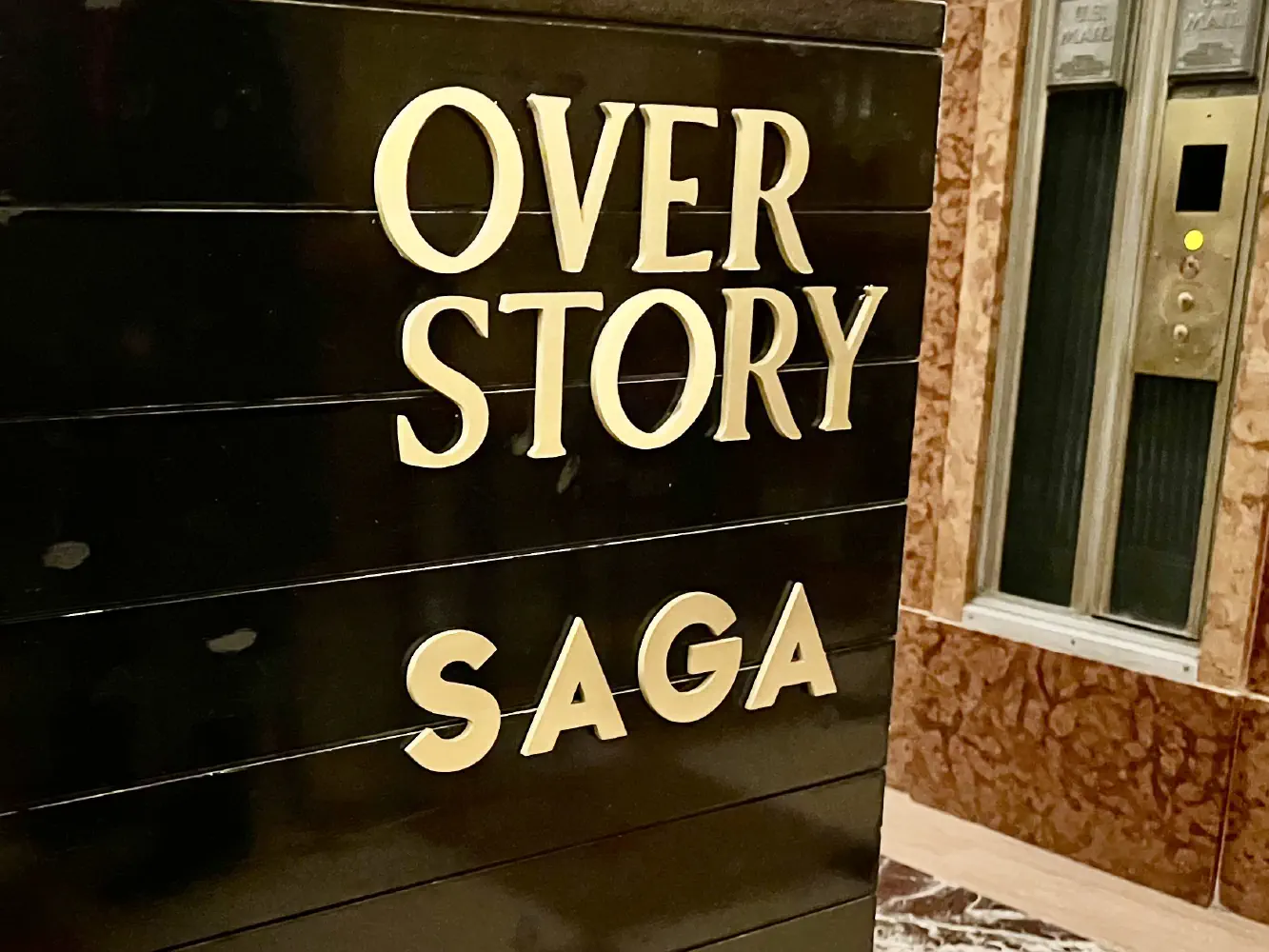
SAGA is a Michelin 2-star restaurant run by the Kent Hospitality Group. The late Chef James Kent received a lot of good reviews for his restaurants, and this one was on my list to try, especially after trying Crown Shy. This restaurant is located in the same landmark Art Deco tower as Crown Shy. Crown Shy is located at the first floor, whereas this one is located on the 63rd floor.
From the website:
The food at SAGA is rooted in European technique but draws inspiration from around the world, primarily the flavors from our childhoods, traveling, and the diverse cuisine in New York City.
Ambiance & Service
We checked in with the host’s table on the first floor just outside of the Crown Shy entrance in the lobby of the building. They asked us to wait about 15 minutes to let the SAGA restaurant know that we were coming in. When we were called, the host hit the top floor of the building for us. Unlike other modern buildings, the ascent to the top was a little slow, and there was no real view other than a massive amount of elevator buttons.
When we arrived, the restaurant’s hosts were waiting for us already. They took our jackets, and we were immediately greeted by the bartender thereafter. As an introductory welcome to the restaurant, they gave us 2 choices for welcome cocktails.
Once the table is ready, they escorted us to 1 of their 2 main dining rooms. We were seated in a corner booth facing the windows. THe views were very cool, but I think Manhatta still has this place beat.
The room is dark and very spacious. We noticed that not all the tables were filled, which is not a bad thing since it makes reservations easier to come by. The service was really good, as the pacing of the dishes and how they took care of us was very timely. We did not feel rushed. The overall dinner took nearly 3 hours, but that might be due to my partner eating 3x as slow as me.
There are 2 different wine pairings:
- “Discovery” - forward-thinking selection of wines, highlighting lesser-known grapes, wine regions, and exciting new products. The four course is $145, and the seven course is $195.
- “Reserve” - selection fo the greatest hits with carefully selected vintages, rare library releases, and special bottles. The four course is $345, and the seven course is $395.
There are also 2 different zero-proof pairings:
- Four course - $75
- Seven course - $95
We opted for the seven course versions of both the wine and zero-proof pairings. There were some add-ons for the meals, which we only opted for the wagyu (+$75) for one of our main courses.
Food
- Welcome Cocktails
- Cocktail - SAGA Margarita
- Amuse - Matsutake Mushroom Tea
- 1st Zero Proof - United Farments 'Jasmine' Kombucha
- 1st Wine Pairing - Martiñolo Trompeteiro
- Course - Variations of Seafood
- 2nd Zero Proof - Steinbock Zero
- 2nd Wine Pairing - Izar-Leku
- Course - Kristal Caviar
- 3rd Zero Proof - Natural Sin Alcohol
- 3rd Wine Pairing - 'Hereafter Here' Chenin Blanc
- Course - Honeynut Squash
- Course - Honeynut Squash (Knafeh)
- 4th Zero Proof - Non 1 'Salted Raspberry & Chamomile'
- 4th Wine Pairing - Wasenhaus 'Grand Ordinaire'
- Course - Black Bass
- 5th Zero Proof - Fade to Black
- 5th Wine Pairing - Sky Mt. Veeder Zinfandel
- Course - Msemmen
- Course - Yogurt
- Course - Dry-Aged Duck
- Course - Salad
- Course - A5 Wagyu
- Course - Hummus
- Course - Harissa
- Course - Thai Chili
- Break - Moroccan Tea
- 6th Zero Proof - Salted Honey Soda
- 6th Wine Pairing - Apple Ice Cider
- Dessert - Chocolate French Cake
- Dessert - Birch, Sweet Potato, and Quince
- Take Home - Chocolate Bars
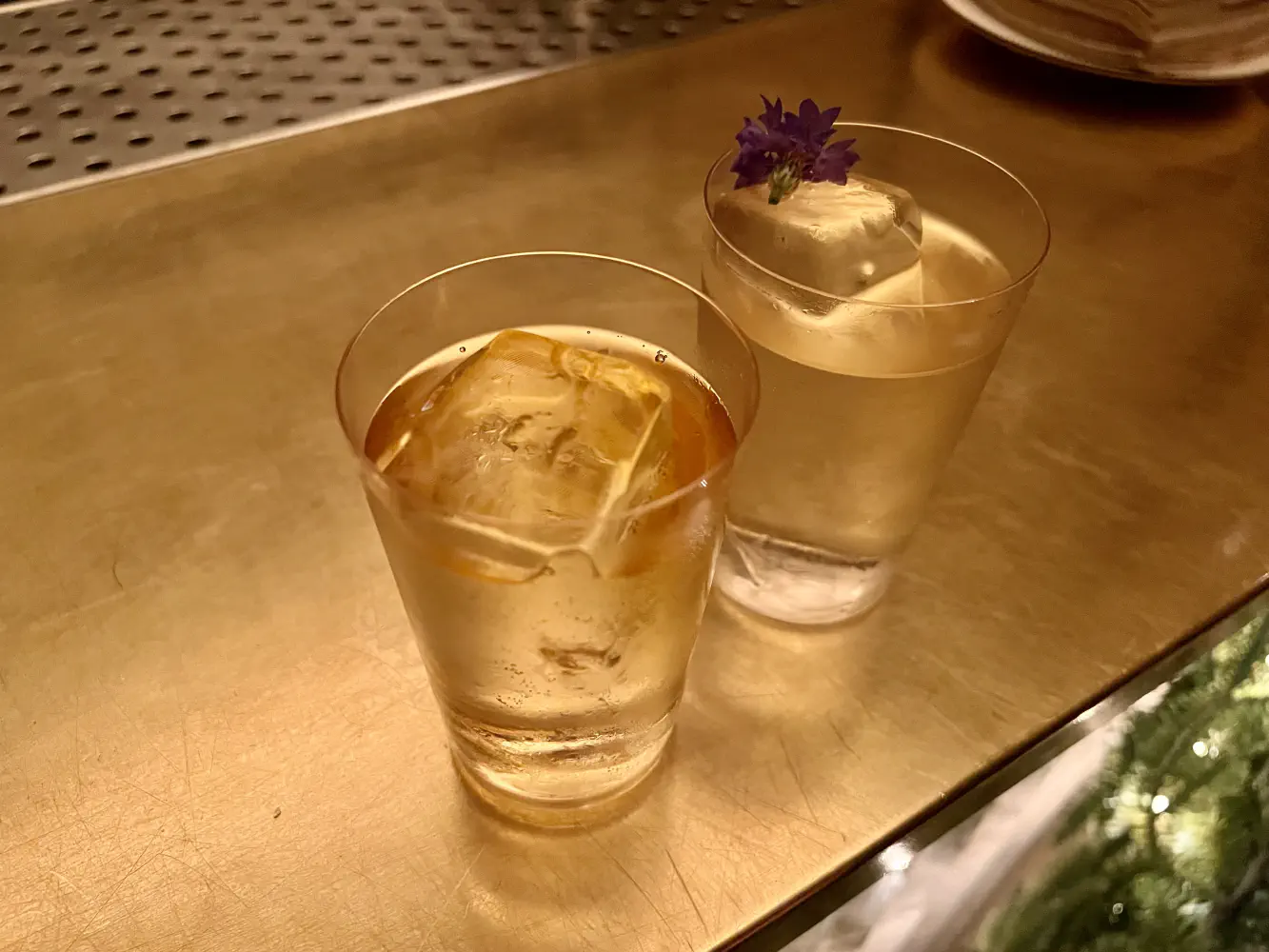
They offered 2 drinks, which came down to alcoholic or non-alcoholic.
I think the non-alcoholic (left) was the Sparkling Himalayan Soda. If so, then it’s made of Nepalese Himalayan black tea with some CO2. I recall that I enjoyed this a lot.
My partner got the alcoholic spritz (right) which I don’t remember what it had. It was slightly sweet and quite smooth as if you don’t even taste the alcohol at all.
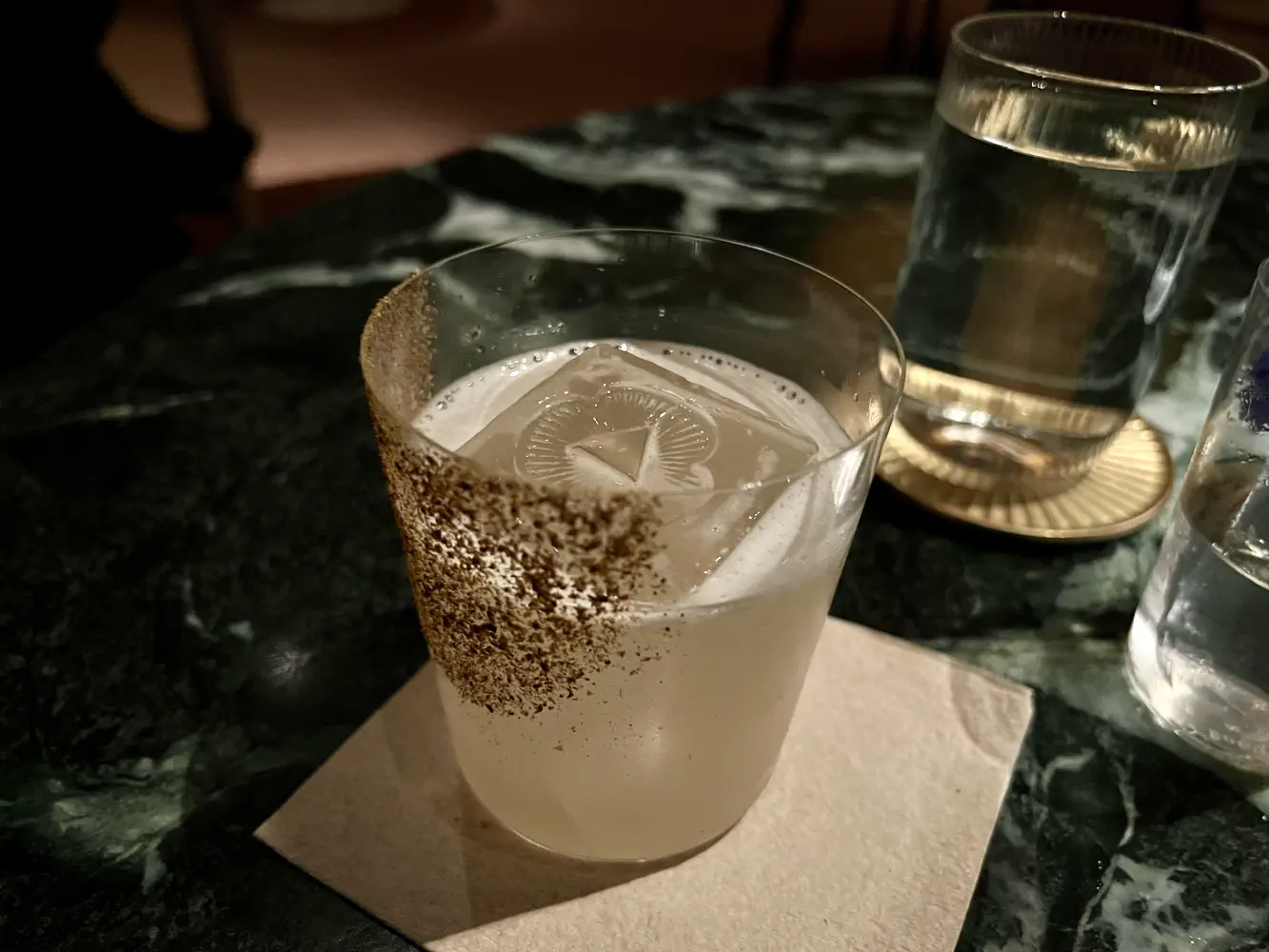
My partner also ordered the SAGA Margarita ($25) which came with tequila, tomato water, mango, lime, and yuzu kosho. This was also surprisingly very smooth and quite tasty.
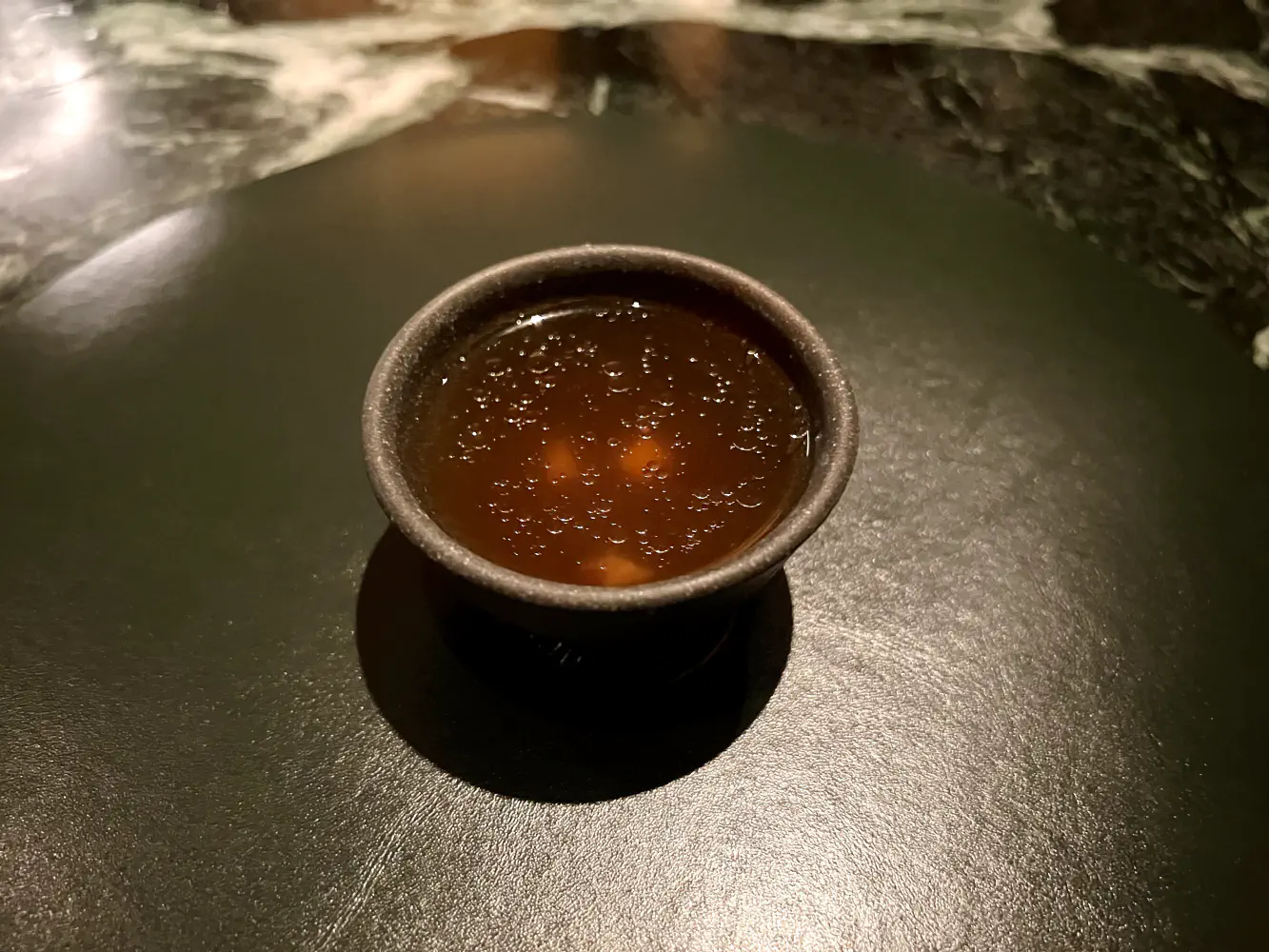
The first starter was a small warm sip of matsutake mushroom tea with bonita dash broth. This surprisingly was very aromatic and nearly free of any mushroom flavors. The mushroom micro pieces themselves were near flavorless and very tender.
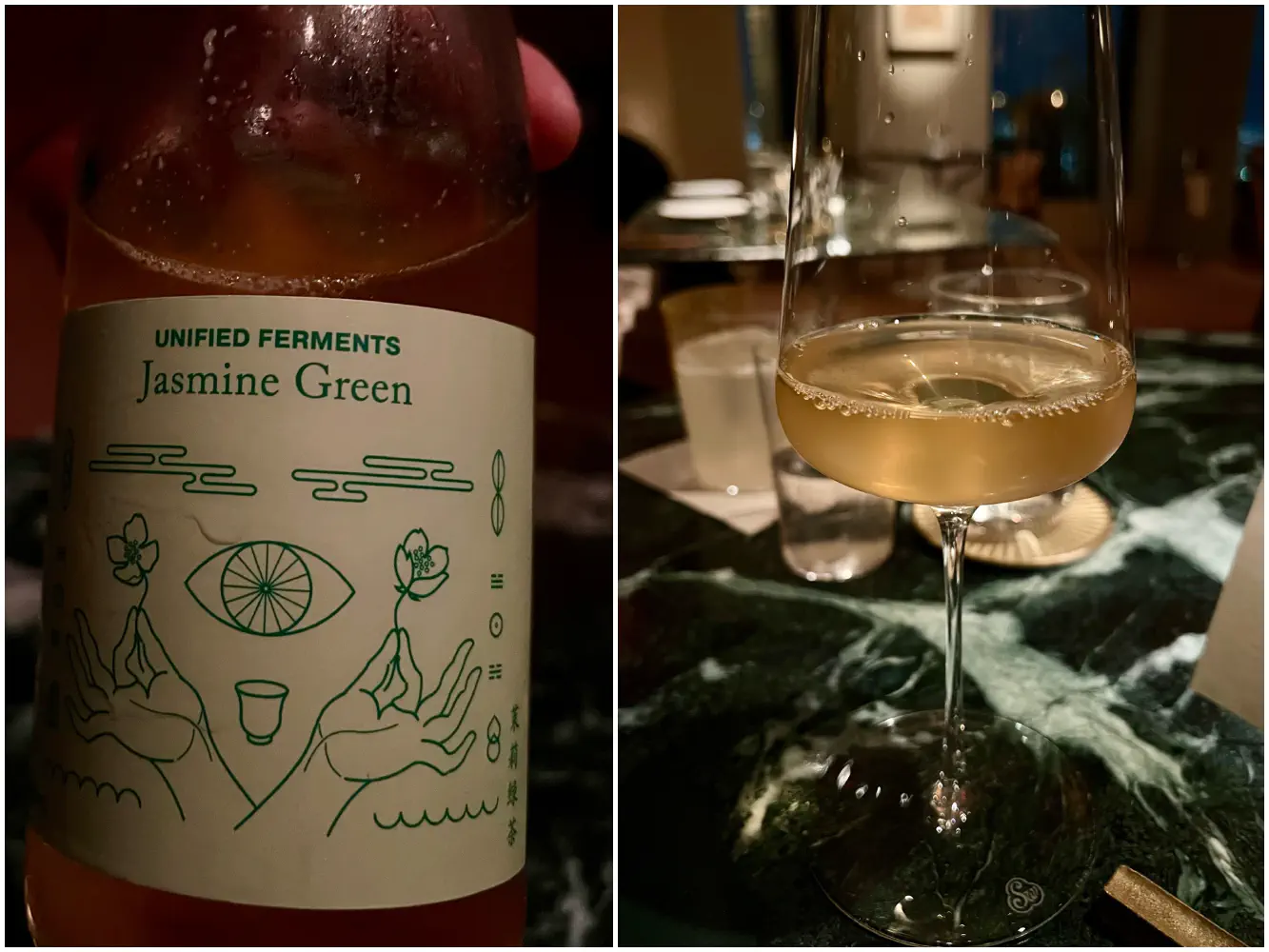
The first non-alcoholic pairing was the United Ferments ‘Jasmine’ Kombucha from Brooklyn, USA. It’s basically jasmine infused kombucha, and it was really good. It was mildly sweet and sparkly.
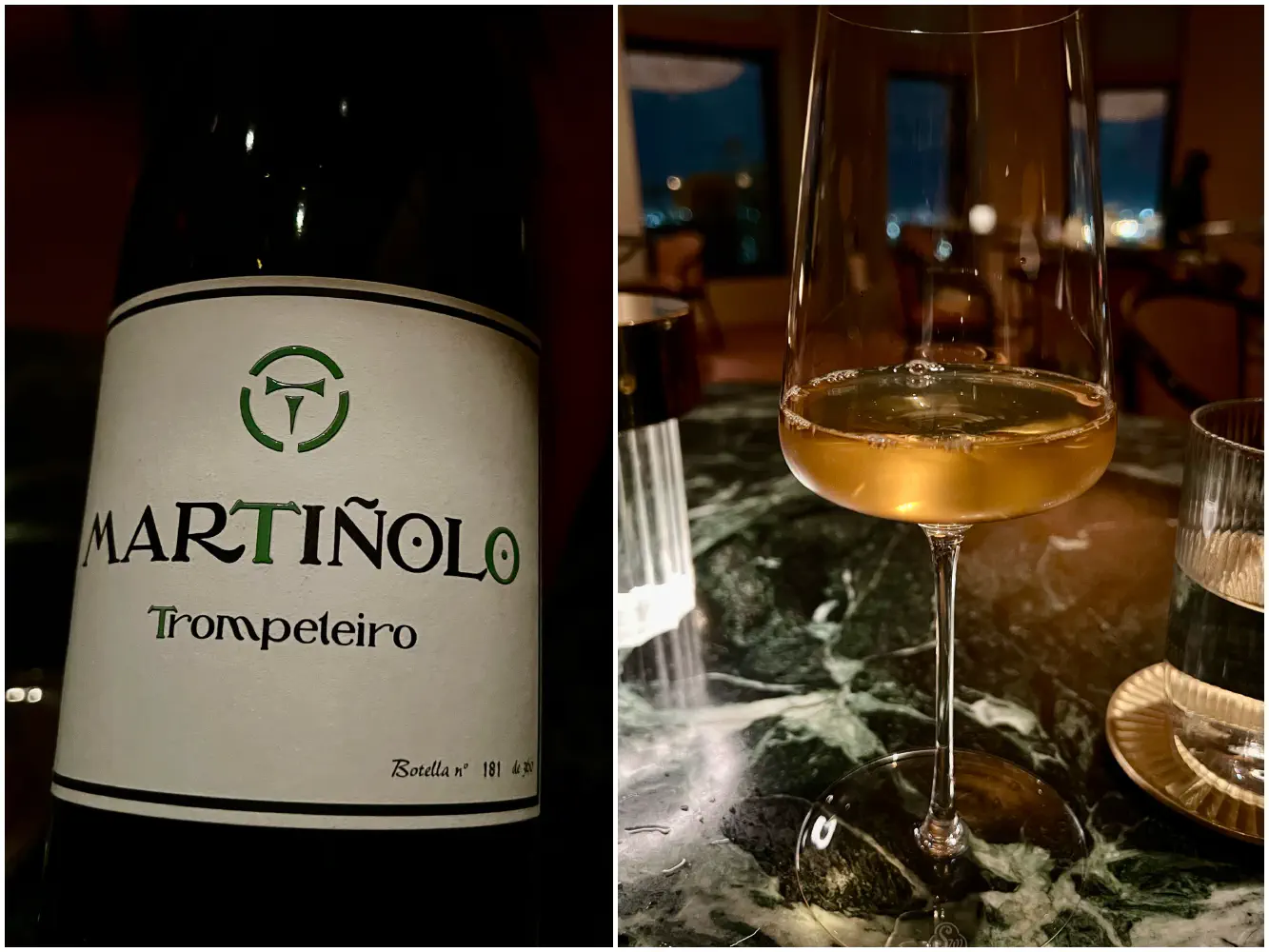
The first alcoholic pairing was the 2020 Entre Cantos ‘Martiñolo Trompeteiro’ Ribeira Sacra from Galicia, ESP. This was very citrus driven and had some sweetness to it.
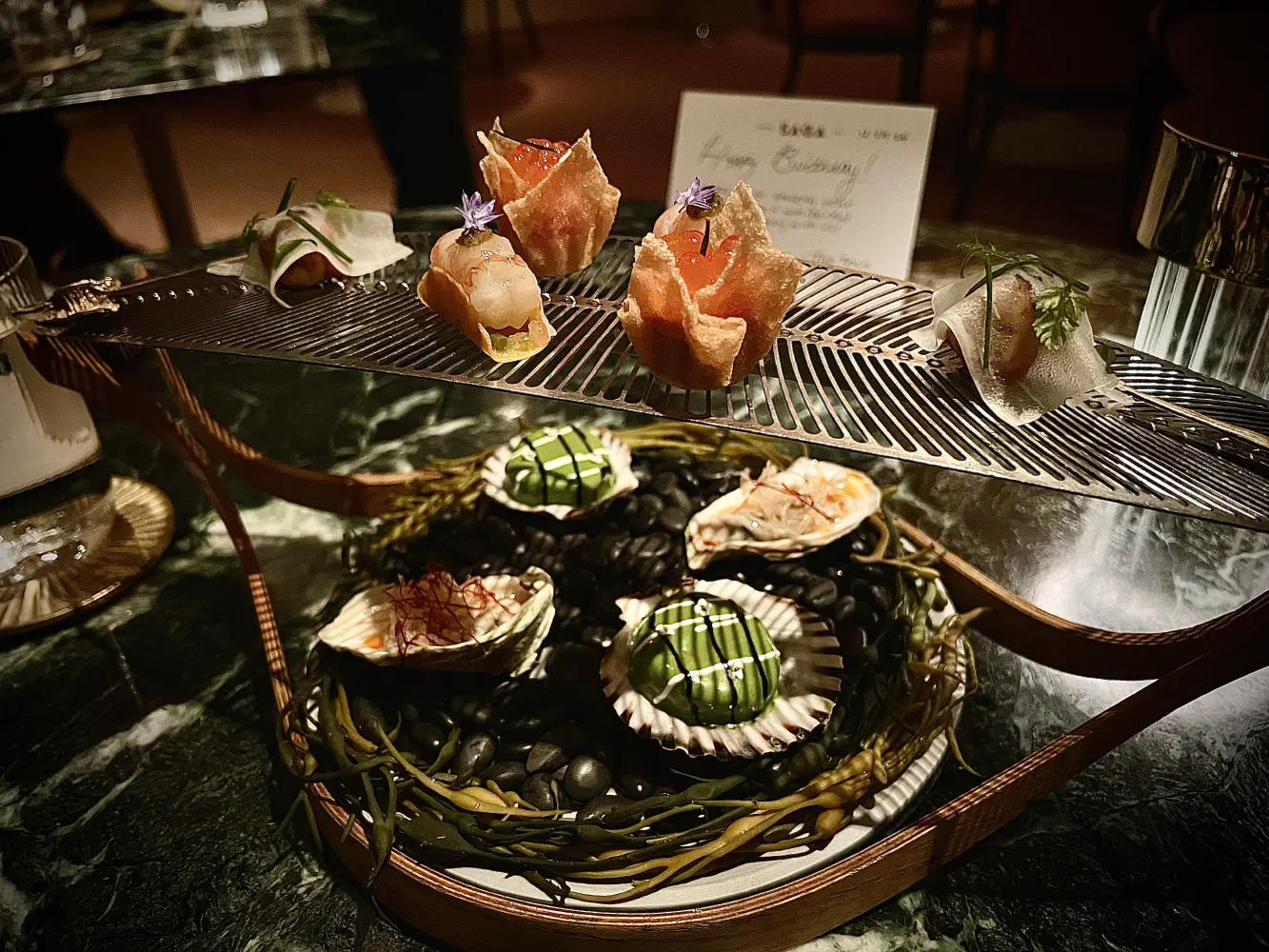
The first course was the Variations of Seafood, which came with spot prawn, octopus, otoro, oyster, and scallop.
On the bottom tier, you have:
- scallop, which was marinated with green curry and vegetable XO sauce. This definitely had some Asian flavors to it, and the scallop was very delectable.
- oyster, which had Thai chili granite and Thai chili oil. This was tasty in that it’s something different to your standard vinaigrette.
On the upper tier, you have:
- octopus, which had spicy daikon. The octopus was perfectly cooked and grilled with a nice chew to it.
- jumbo prawn, which had a taco shell with apple relish. The prawn was plump, and the overall one-biter reminded me of dipping a tortilla chip in one of those store-bought tomato salsas.
- otoro, which came with a crisp pastry filled with bluefin tuna belly, creamed wasabi miso sauce, and layered with some fish eggs. The wasabi was very prominent, but it wasn’t spicy at all. The whole bite was very good.
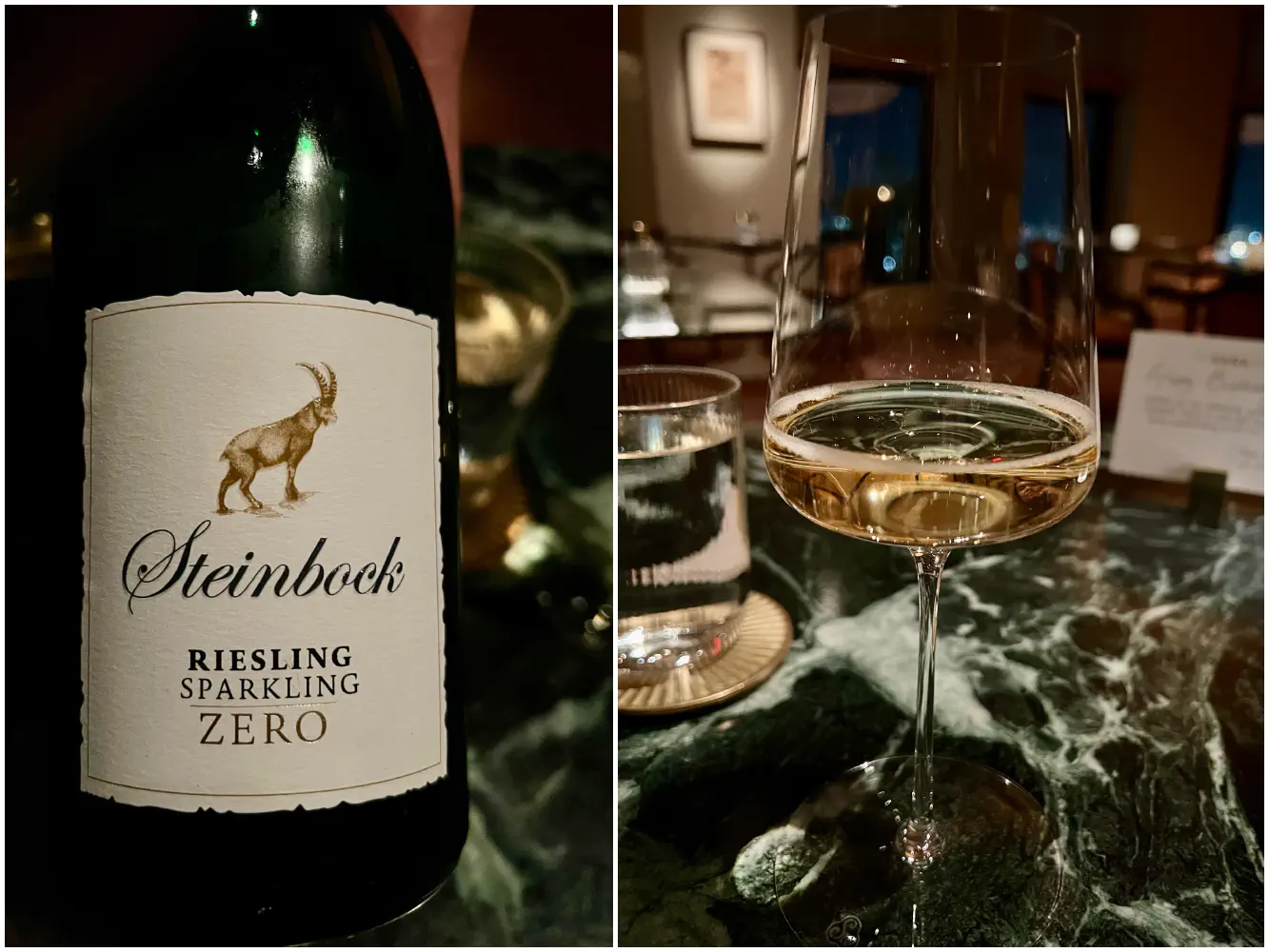
The second non-alcoholic pairing was the Dr. Fischer ‘Steinbock Zero’ Sparkling Riesling from Rheinhessen, DEU. This literally tastes like a riesling just without the alcohol. It did remind me a little of a Martinelli’s apple cider, except it wasn’t so micro-bubbly.
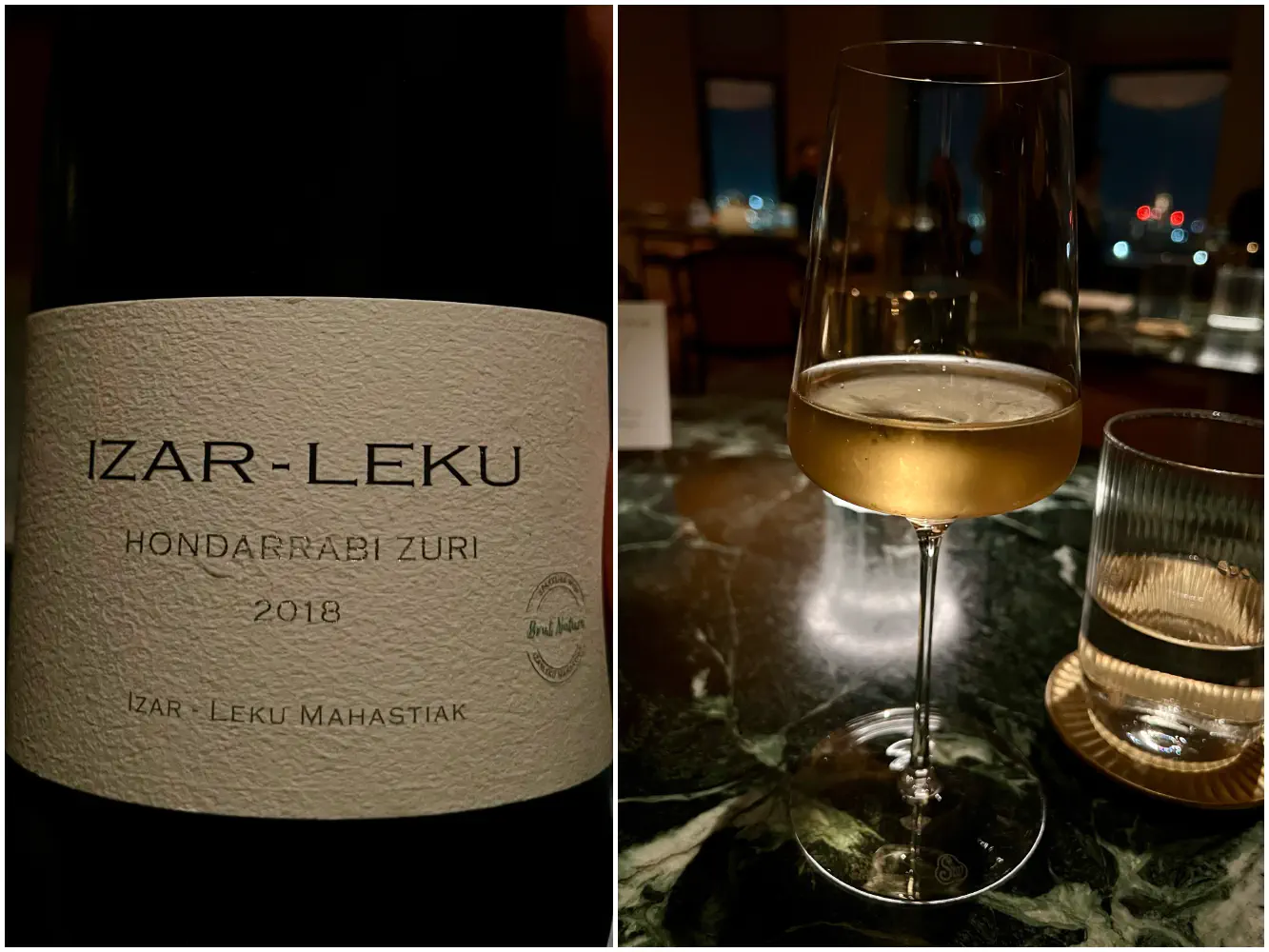
The second alcoholic pairing was the 2018 Izar-Leku Vino Espumoso from Basque Country, ESP. It’s a blendn of 92% Hondarribi Zuri and 8% Hondarribi Beltza. This was similar to a very sparkling champagne, and it had a full mouthfeel to it with very nice citrus zest.
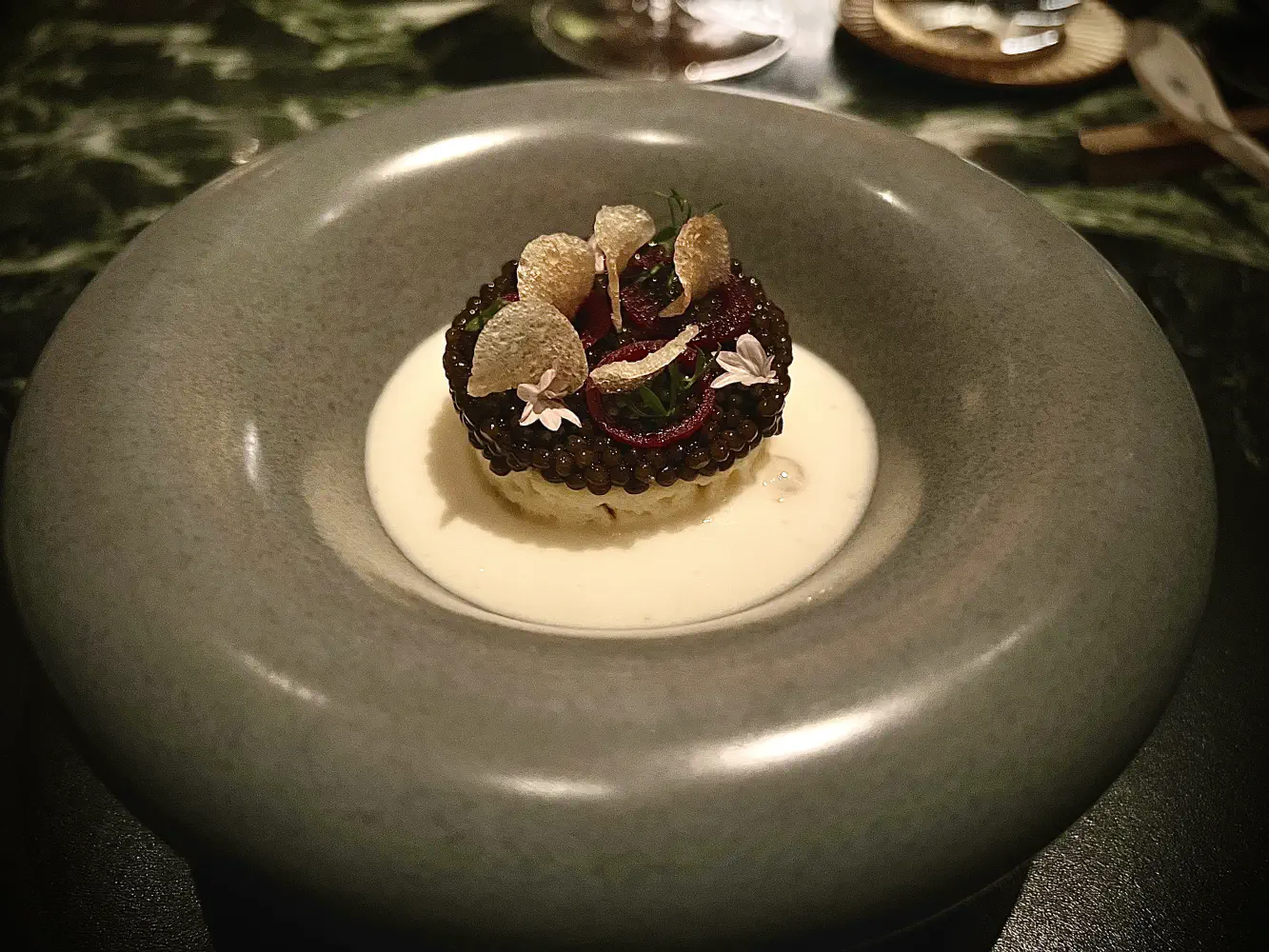
The second course was the Kristal Caviar, which came with tamago, bonito, and brown butter. Tamago is a Japanese omelette. I’ve never thought about putting caviar on top of an egg omelette, but it surprisingly worked here. The brown butter sauce was of course delicious. What was nice about this dish was that the egg was pretty solid, so it gave the caviar some ground to stand on as you scooped each bite.
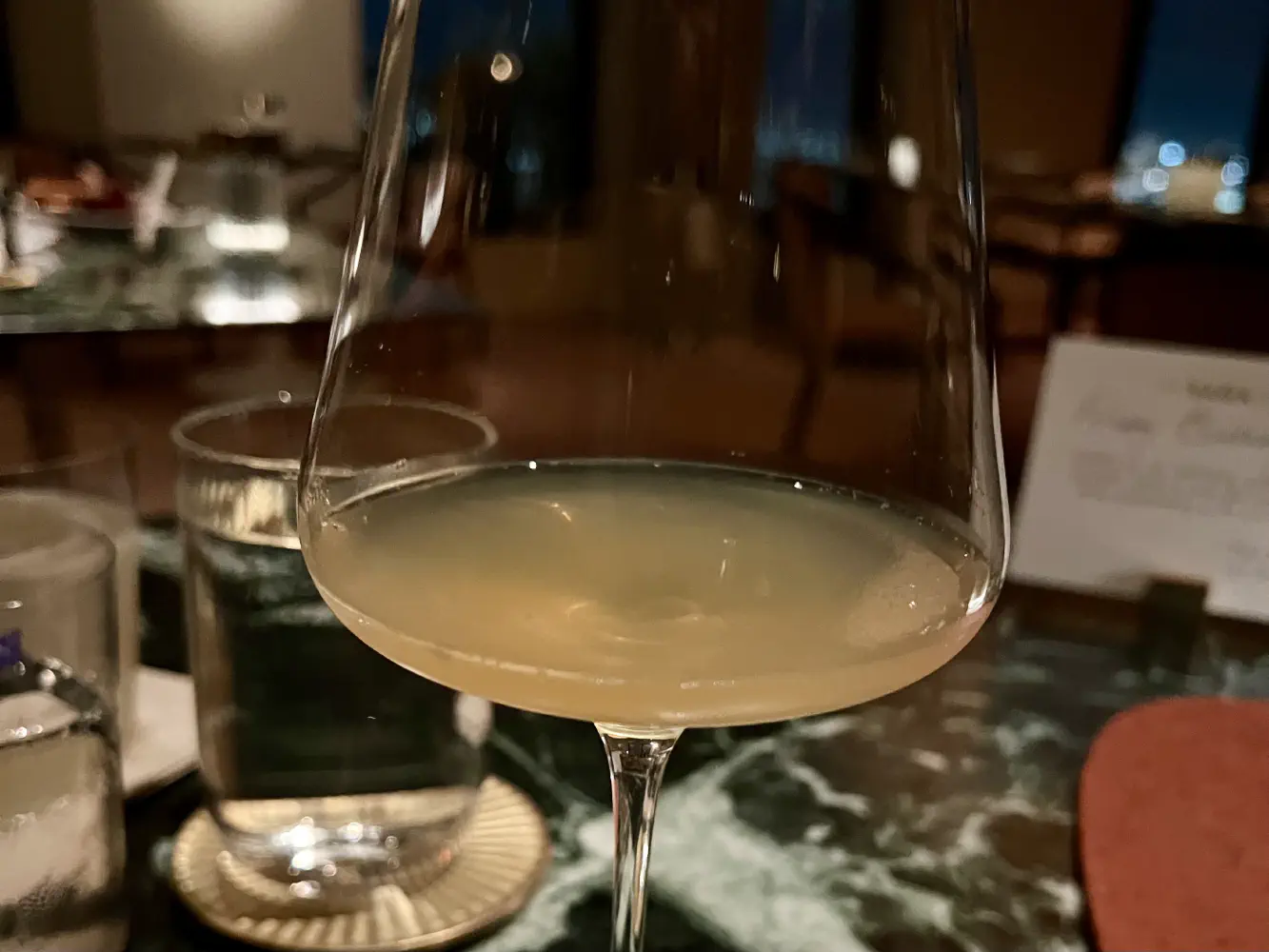
The third non-alcoholic pairing was the Trabanco ‘Natural Sin Alcohol’ Cider from Asturias, ESP. This definitely tasted like a very organic, complex tart apple cider. It wasn’t poured raw, and instead came from the bar. The bartender added some honey and some other things to give it a little brightness to it.
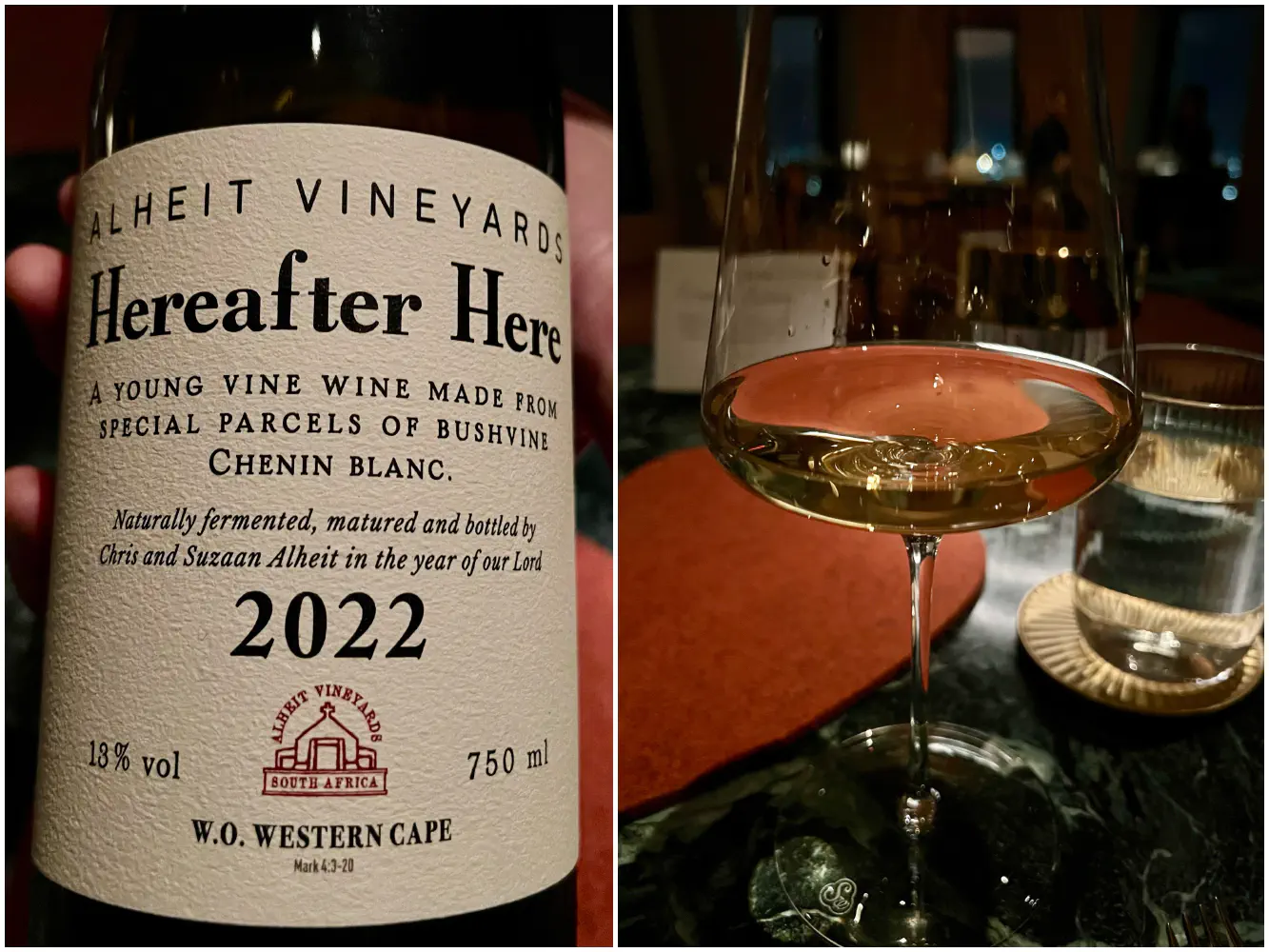
The third alcoholic pairing was the 2022 Alheit Vineyards Chenin Blanc ‘Hereafter Here’ from Hemel-in-Aarde ZAF. I feel like the Chenin Blanc grape is quite underrated as well as South African wines. This one smells very bright and fresh with some citrus blossoms. The taste was medium body with very nice minerality to it. It was so good that my partner, who typically despises anything other than rieslings, asked for more sips of it.
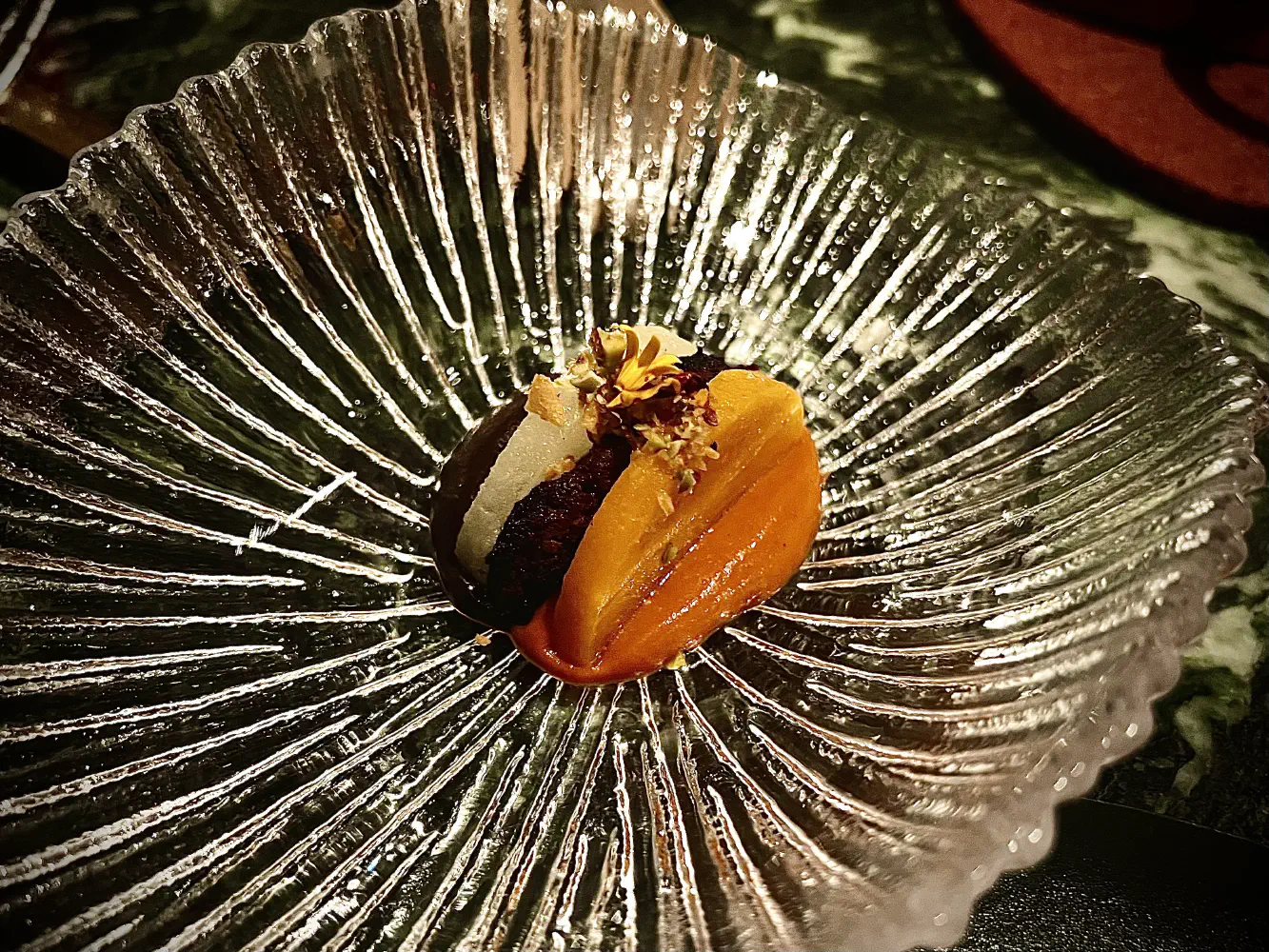
The third course was the Honeynut Squash came with morcilla, knafeh, and chicory. It was presented with three different preparations around the single ingredient of a fermented honeynut squash.
This was a compressed apple, morcilla sausage, and butternut squash.
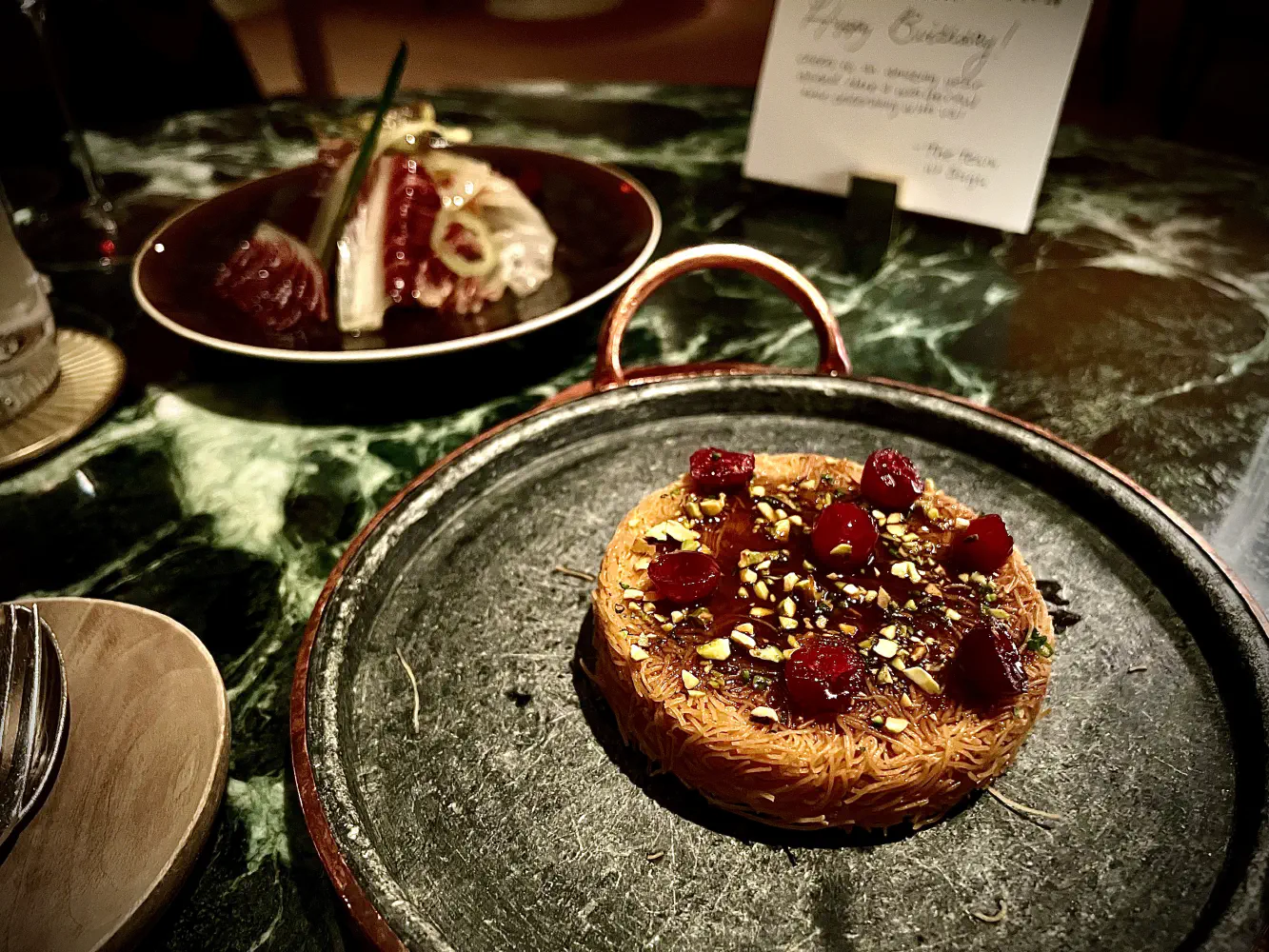
This knafeh was the main star of the fourth course and is common in places like Turkey and Israel. It’s made of filo dough, pistachio, and cheese, and stuffed with fermented honeynut squash. This was quite dense, and paired excellently with both our drinks.
At the far left, there was a bitter green salad with more squash in it.
This was similar to something we had at Miriam.
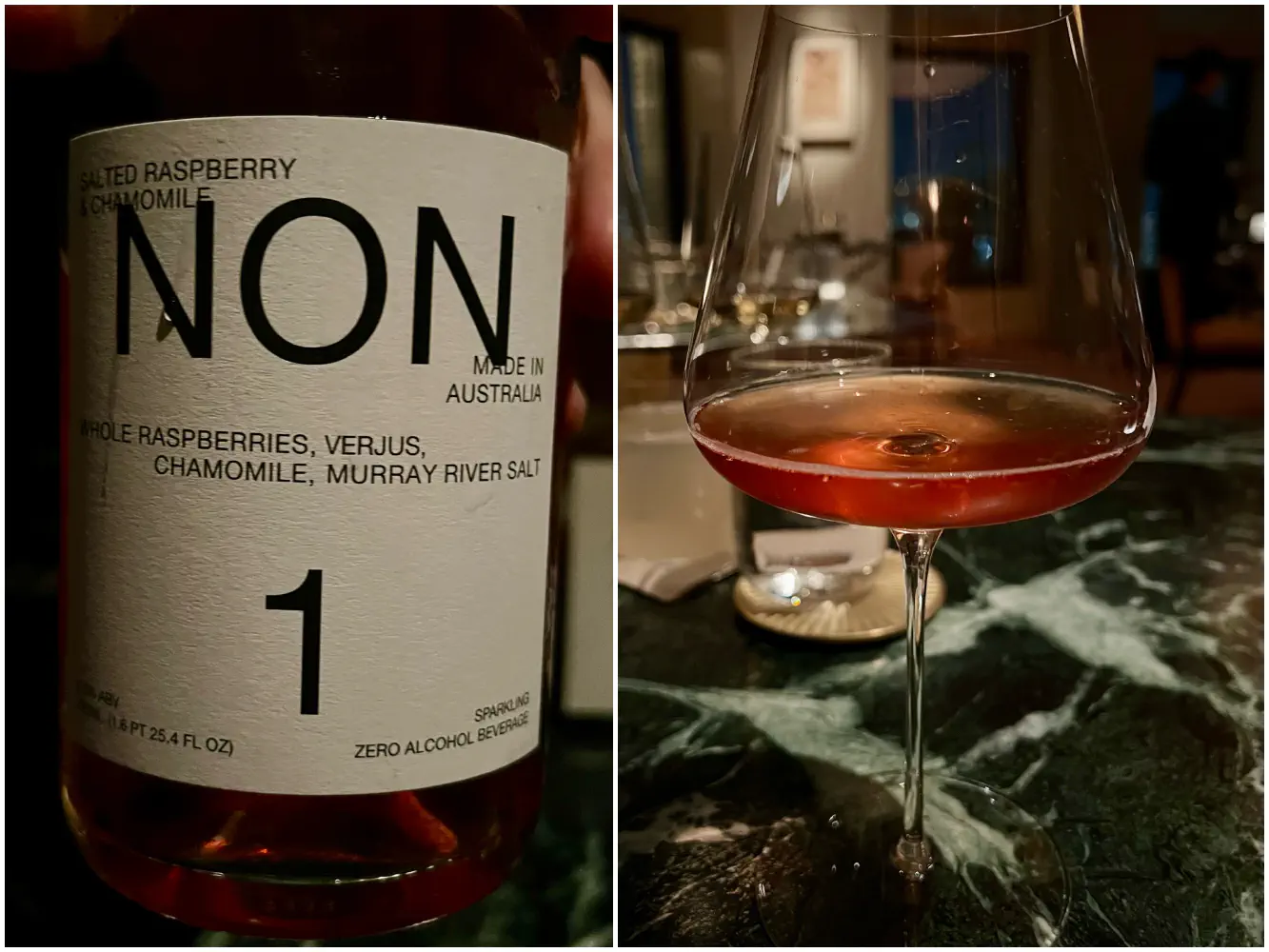
The fourth non-alcoholic pairing was the Non 1 ‘Salted Raspberry & Chamomile’ Verjus from Victoria, AUS. This tasted floral with some of the sweetness from raspberries. It was very balanced, sparkly, and very refreshing.
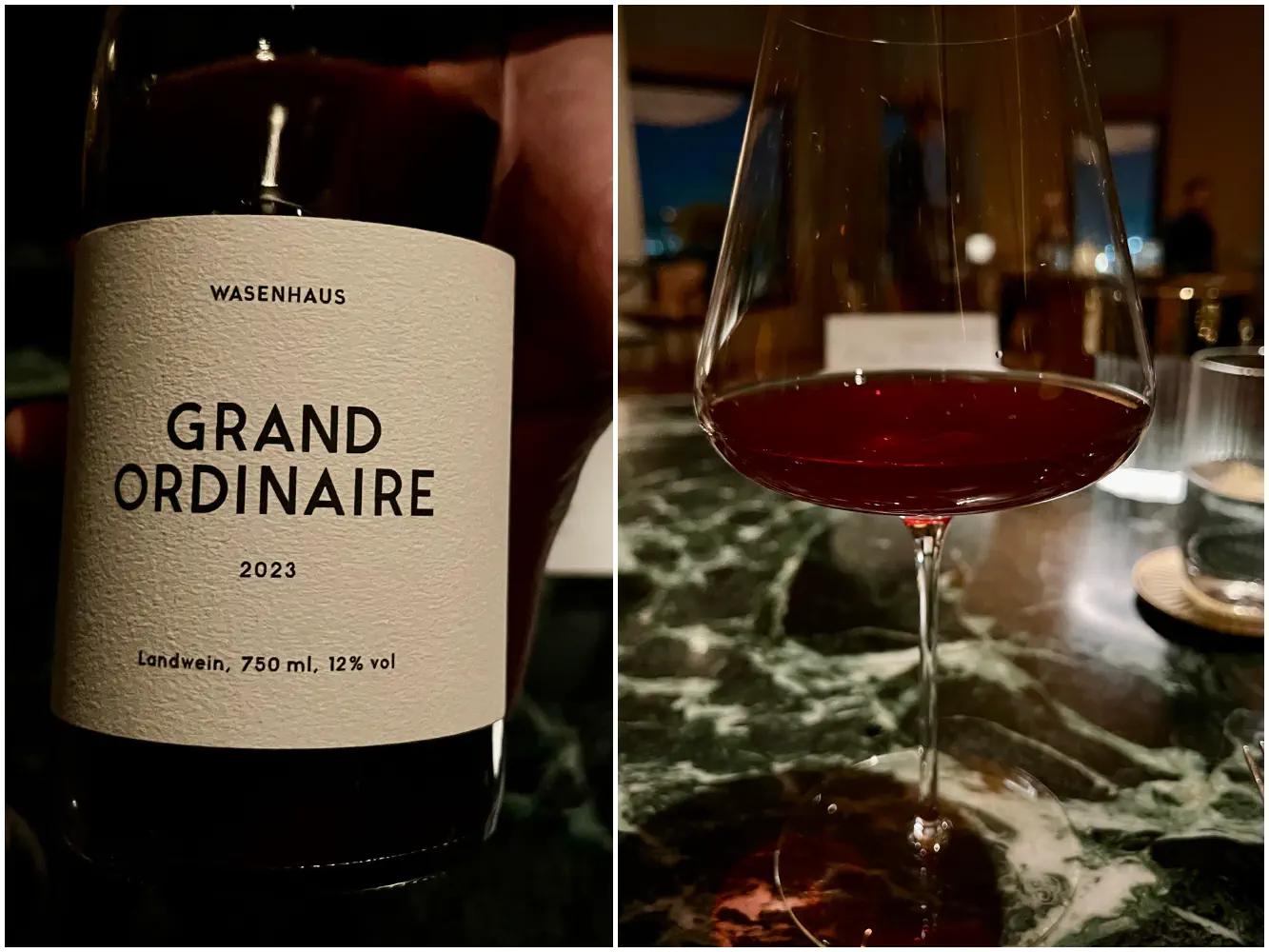
The fourth alcoholic pairing was the 2023 Wasenhaus ‘Grand Ordinaire’ Spätburgunder from Baden, DEU. This was an entry level, modern organic style of pinot noir with red fruit flavors. The colors of this looks like fruit punch, but it tasted very complex and smooth.
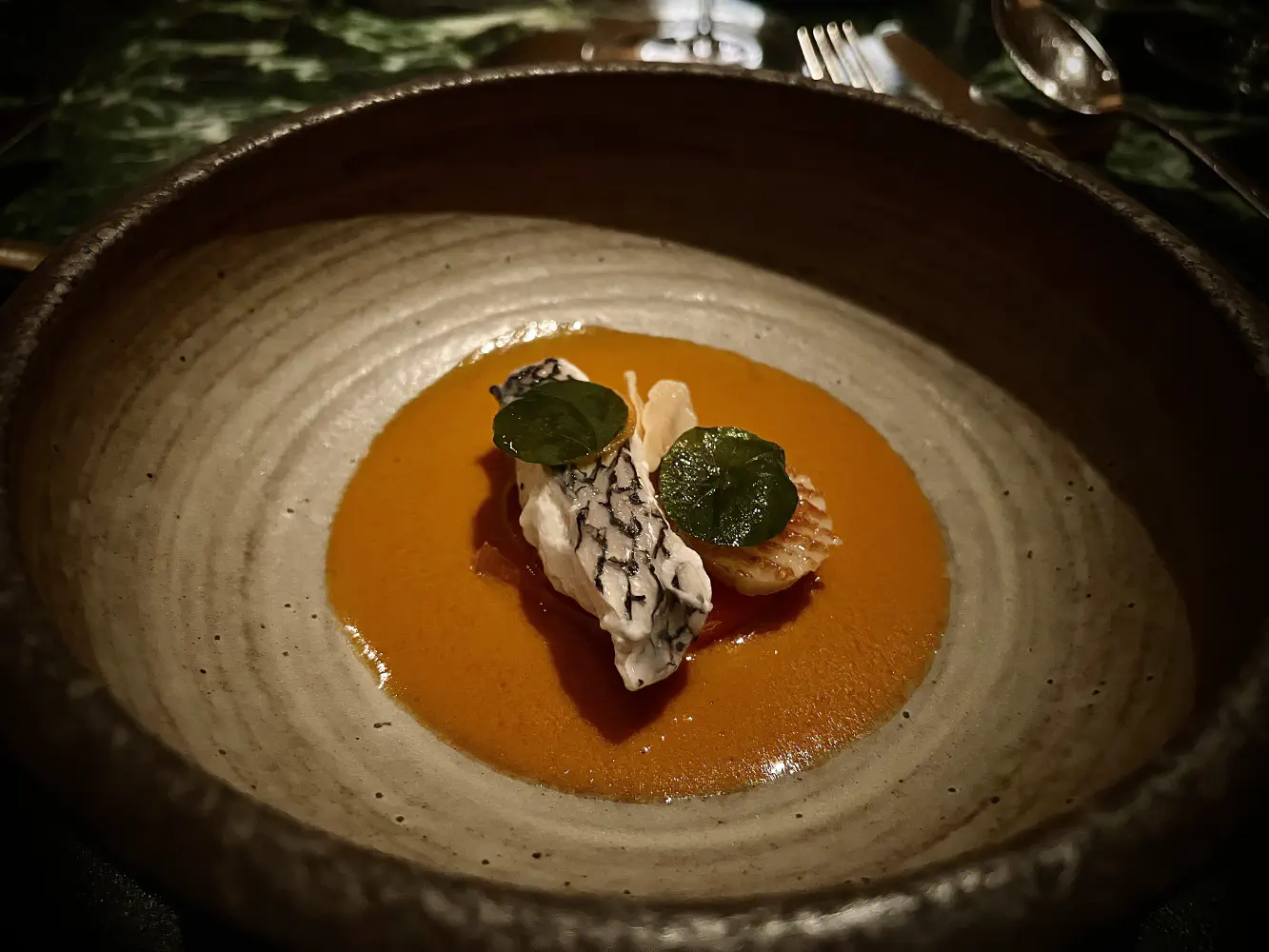
The fourth course was the dashi poached Black Bass came with scallop, clam, carrot, and sesame. The bass was very meaty and perfectly cooked.
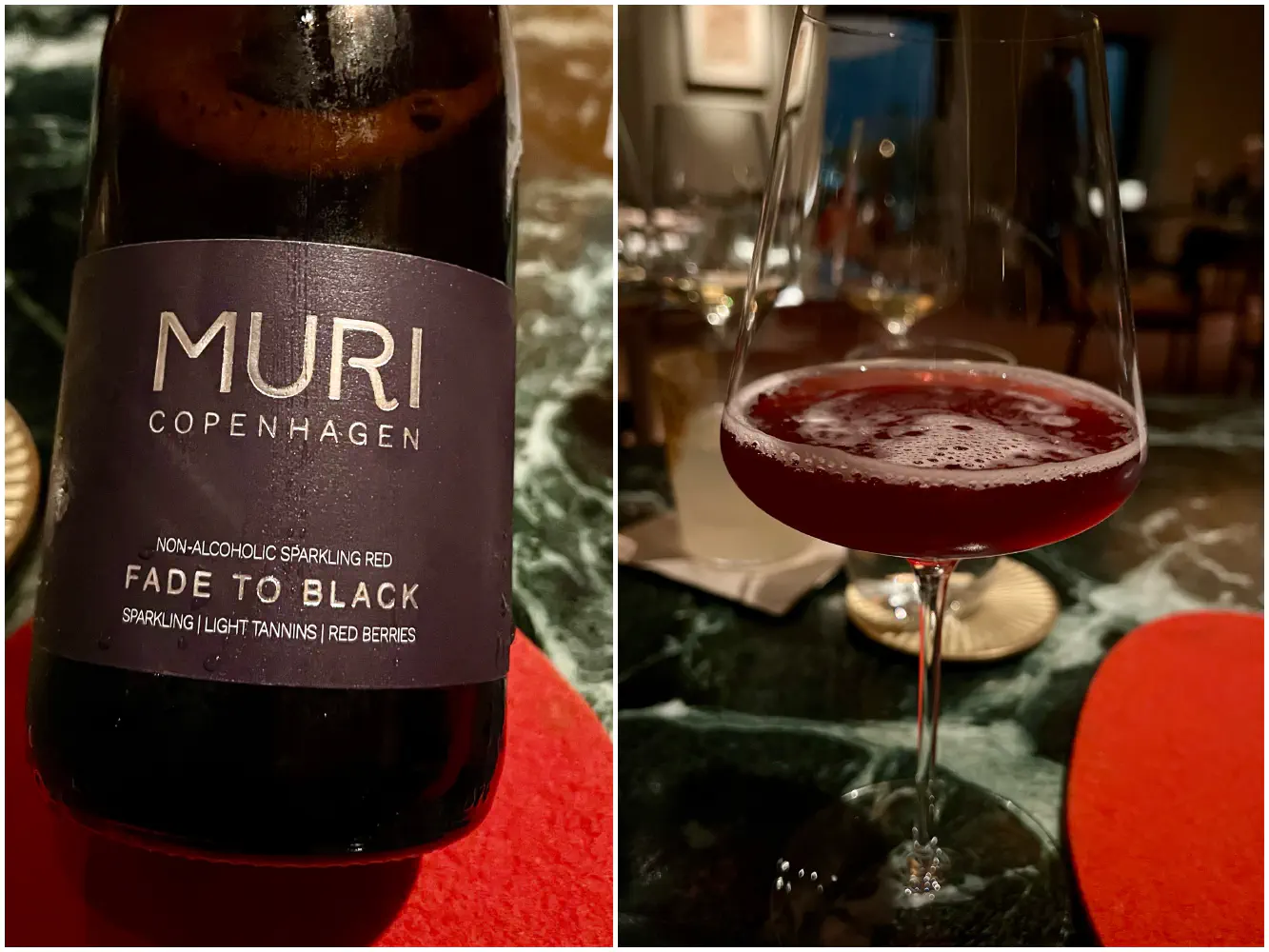
The fifth non-alcoholic pairing was the Muri Drinks Co ‘Fade to Black’ Currant Piquette from Copenhagen, DNK. This was a sparkling red, with a blend of teas, fruits, and herbaceous notes.
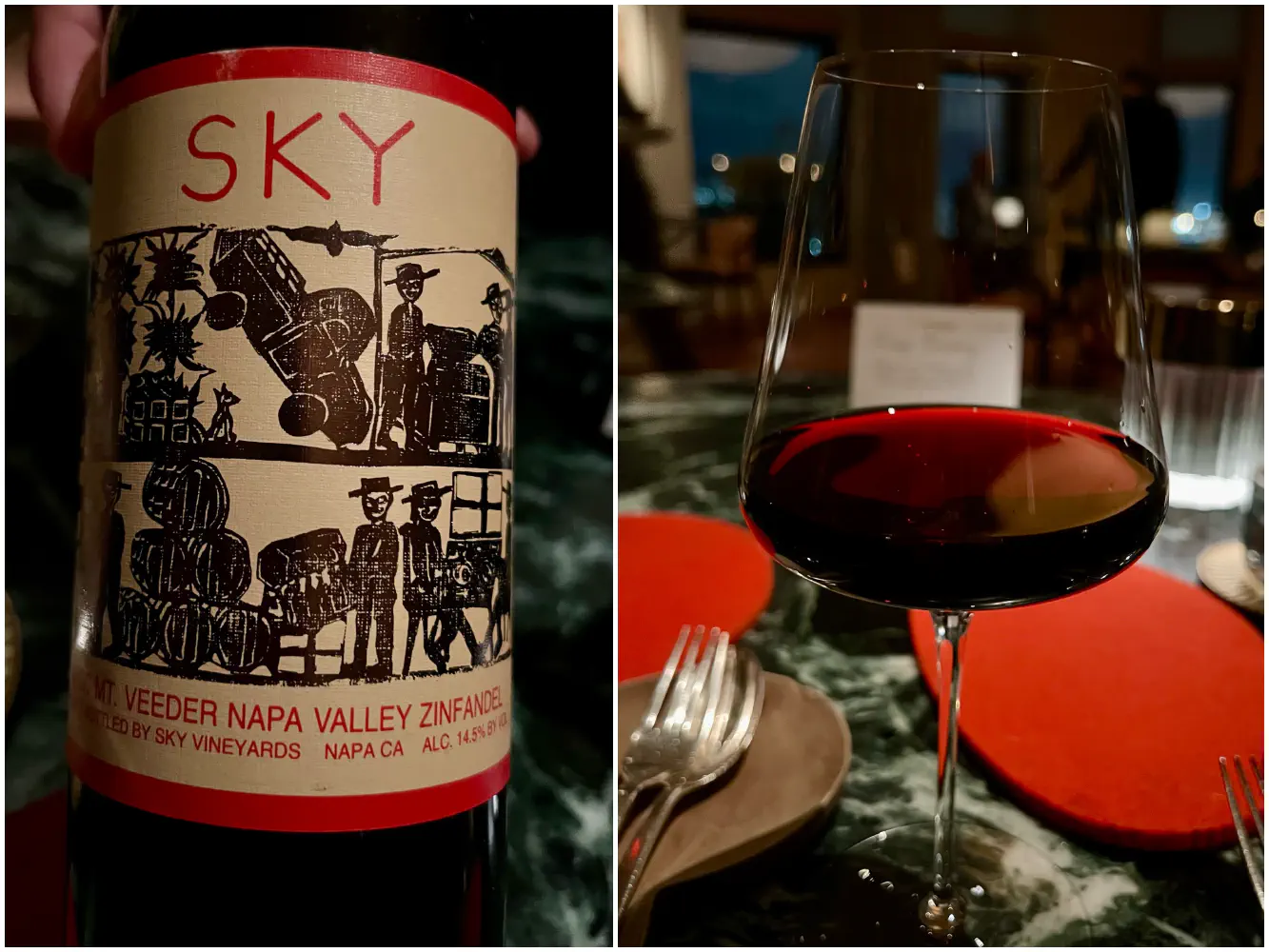
The fifth alcoholic pairing was the 2000 Sky Vineyard Mt. Veeder Zinfandel from Napa Valley, USA. The winemaker decided to released this wine to the market. It has blueberry, bay leaf, juniper, and other red fruits. It was a pretty complex red wine, though it reminded me of why I was not a huge fan of zinfandels. This wine’s notes felt more subdued and straightforward than punchy and exquisite, so it wasn’t as fun drinking this.
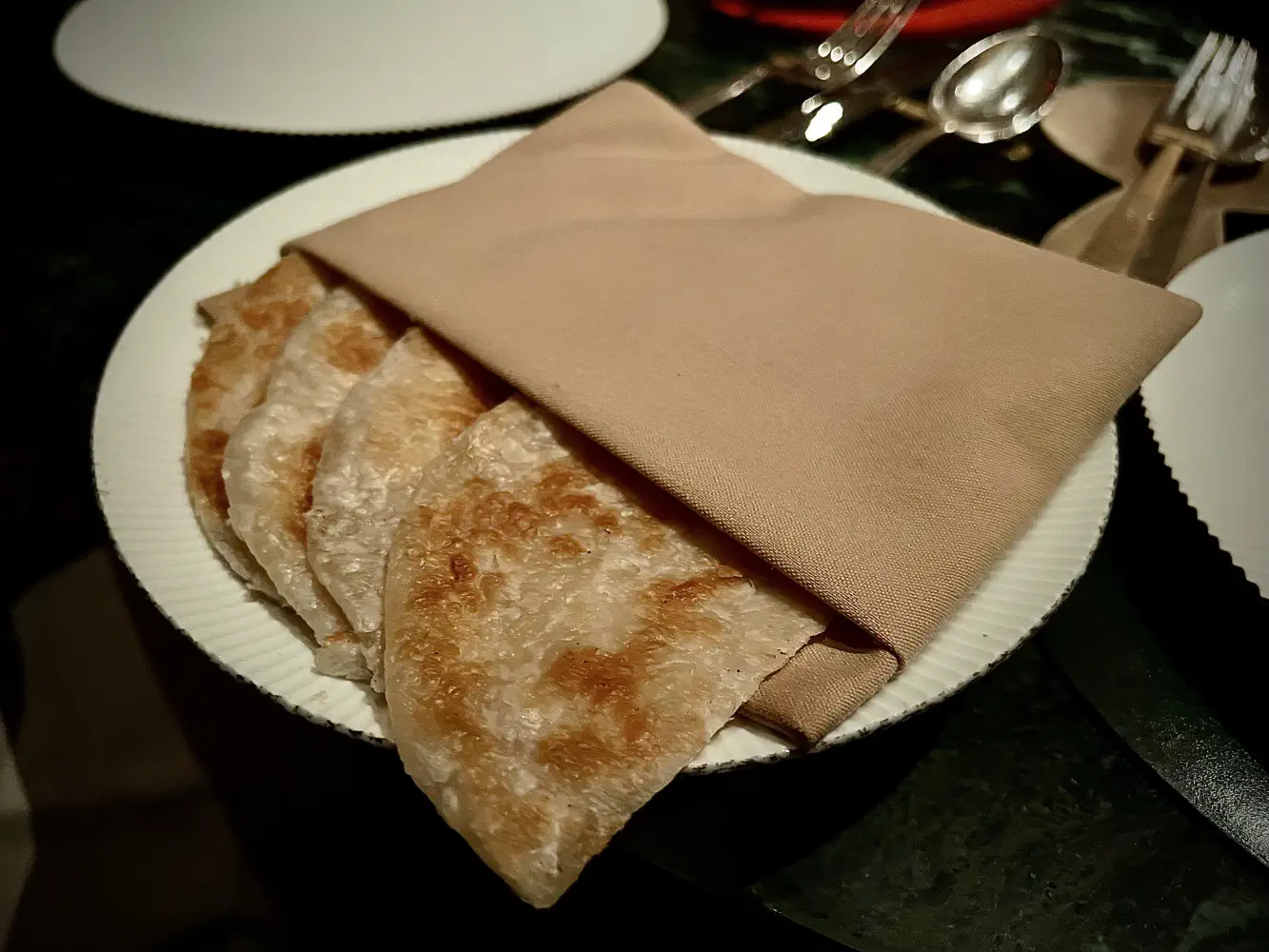
And now the final sixth savory course which was framed around Moroccan tagines. They served us msemmen, which was Moroccan flat bread. The bread had a texture similar to Chinese scallion pancakes.
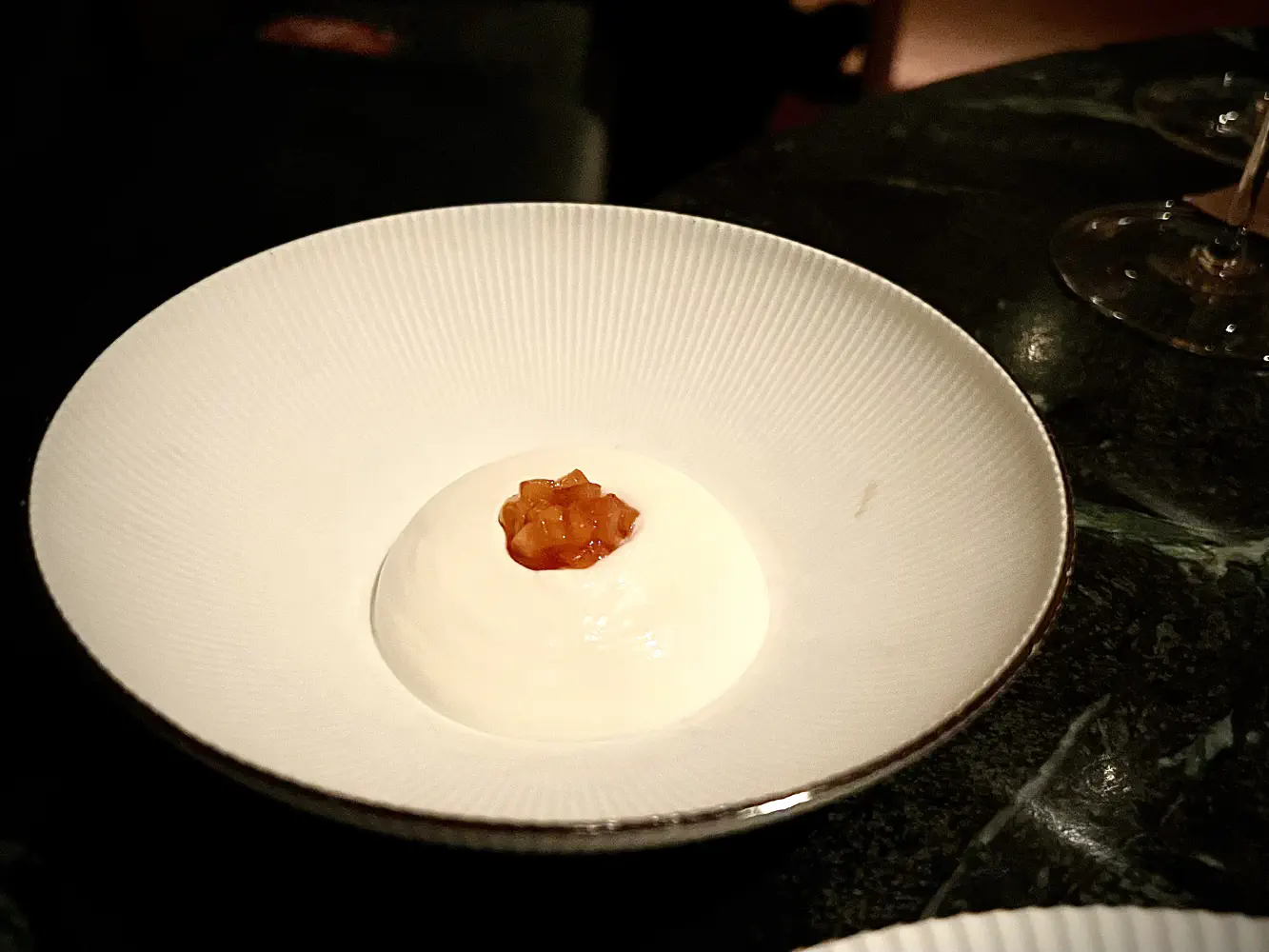
The yogurt was similar to Greek yogurt, but a bit more refined and dense.
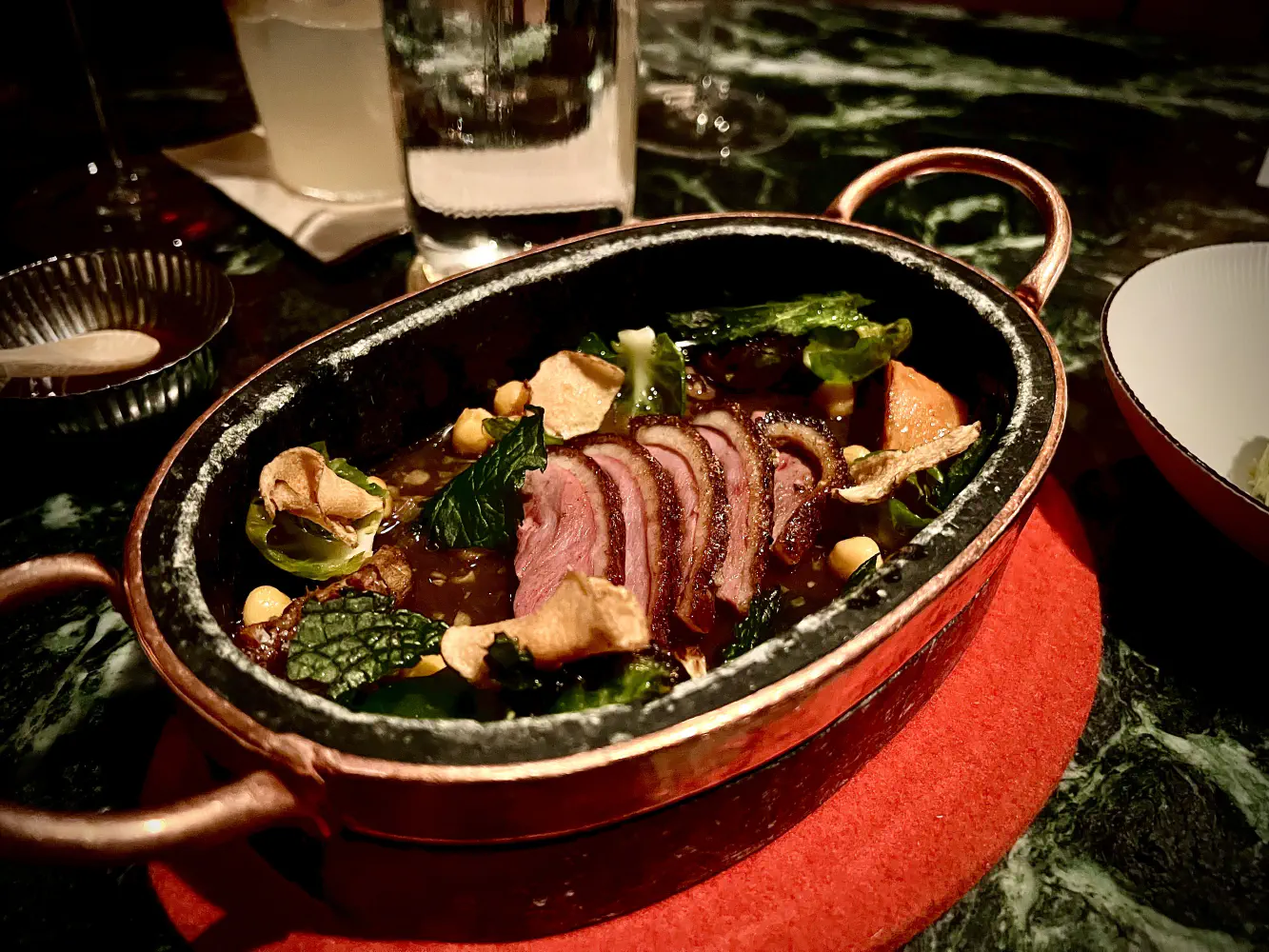
The Long Island Dry-Aged Duck came with braised beef tongue and sunchokes. The duck bread was very tender and flavorful.
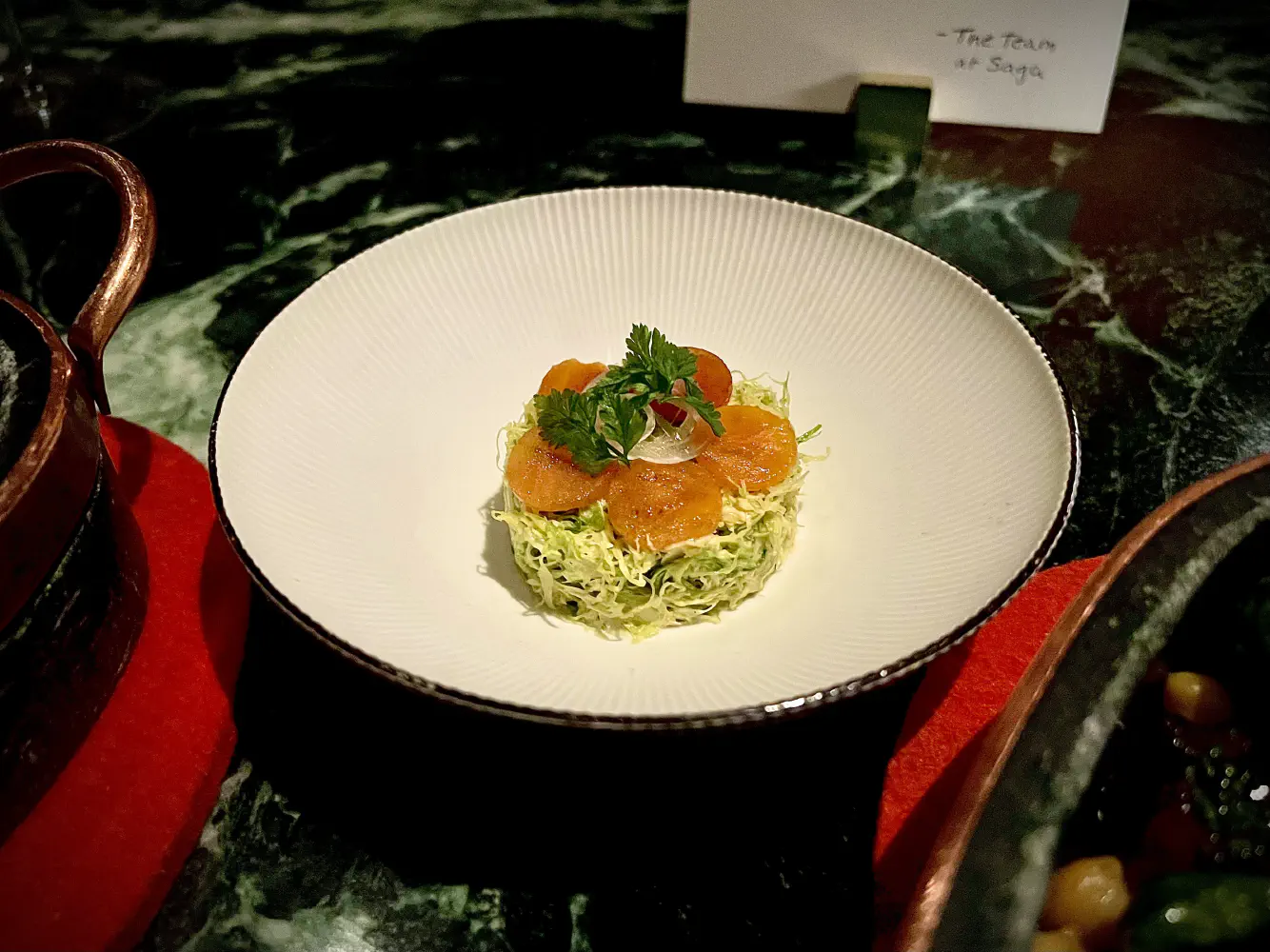
The brussel sprout and persimmon salad was crunchy and contrasted nicely with the richness of the jus that the duck and wagyu sat in.
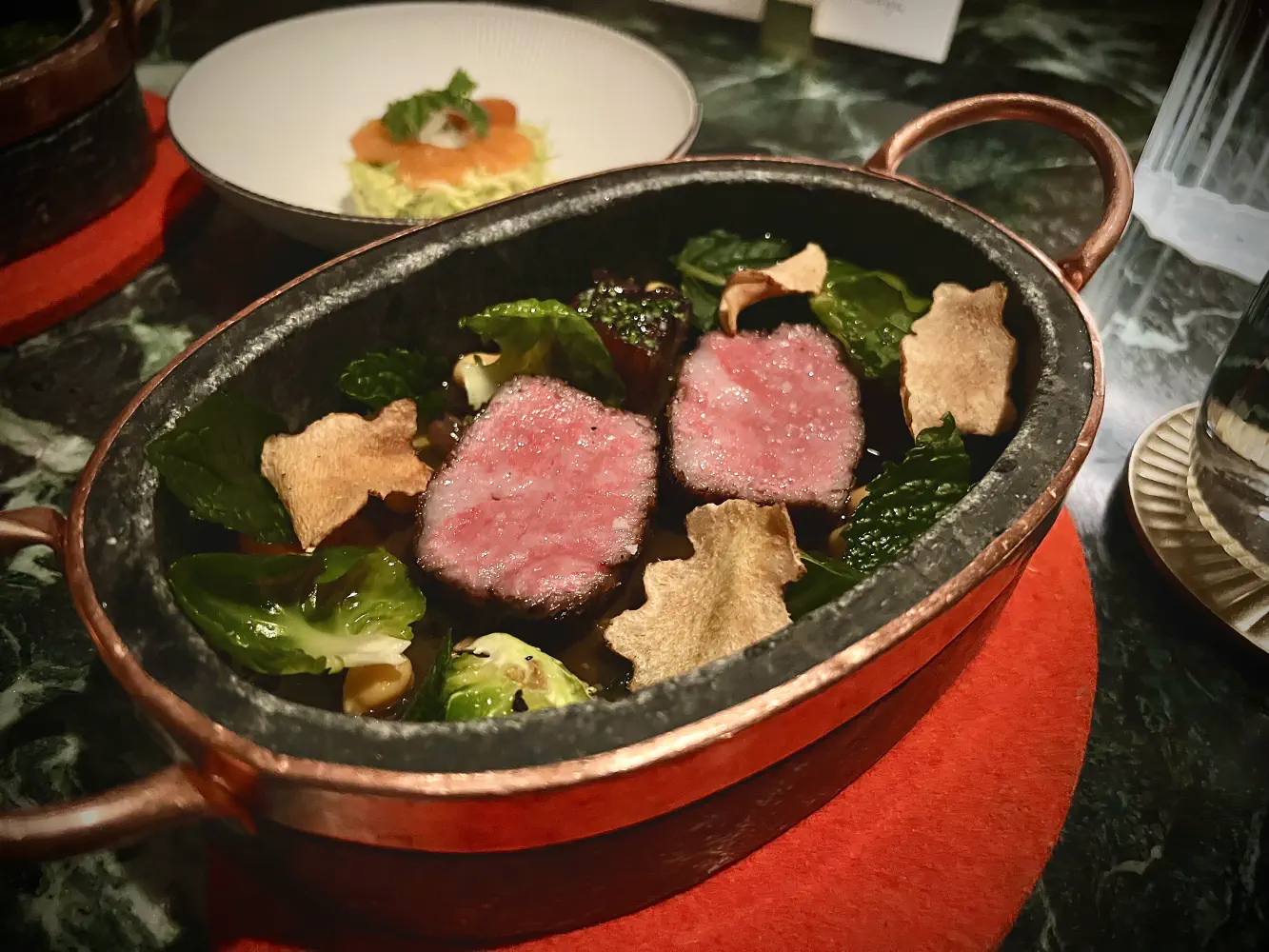
The A5 Miyazaki Wagyu (+$75 add-on) strip loin also came with braised beef tongue and sunchokes. This replaced my order of the Long Island duck. The wagyu was super tender and very delicious. It was cooked perfectly.
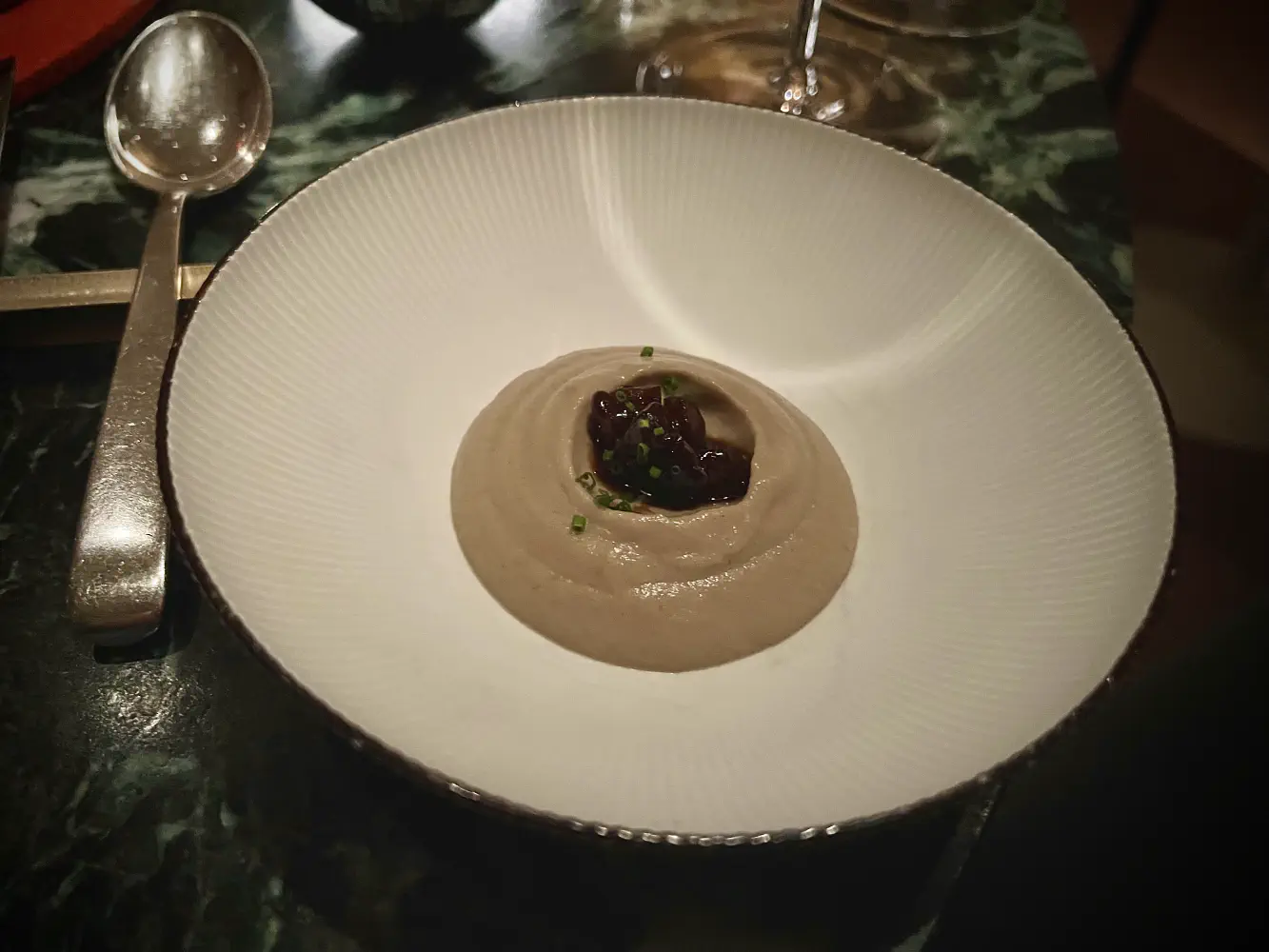
The roasted hummus was very good, and it tasted like it was freshly made.
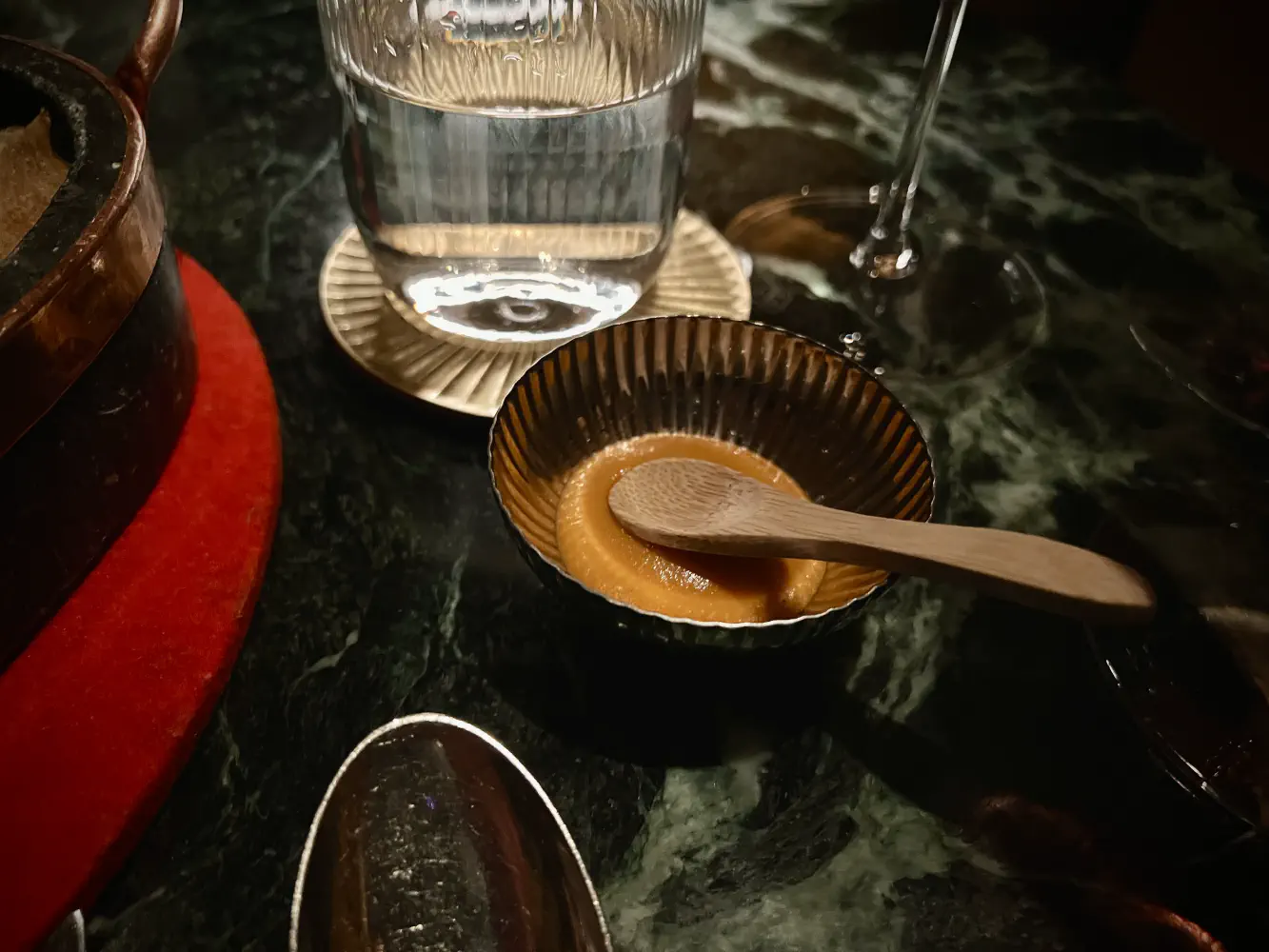
The harissa hot sauce was pretty good, though I didn’t use it that much.
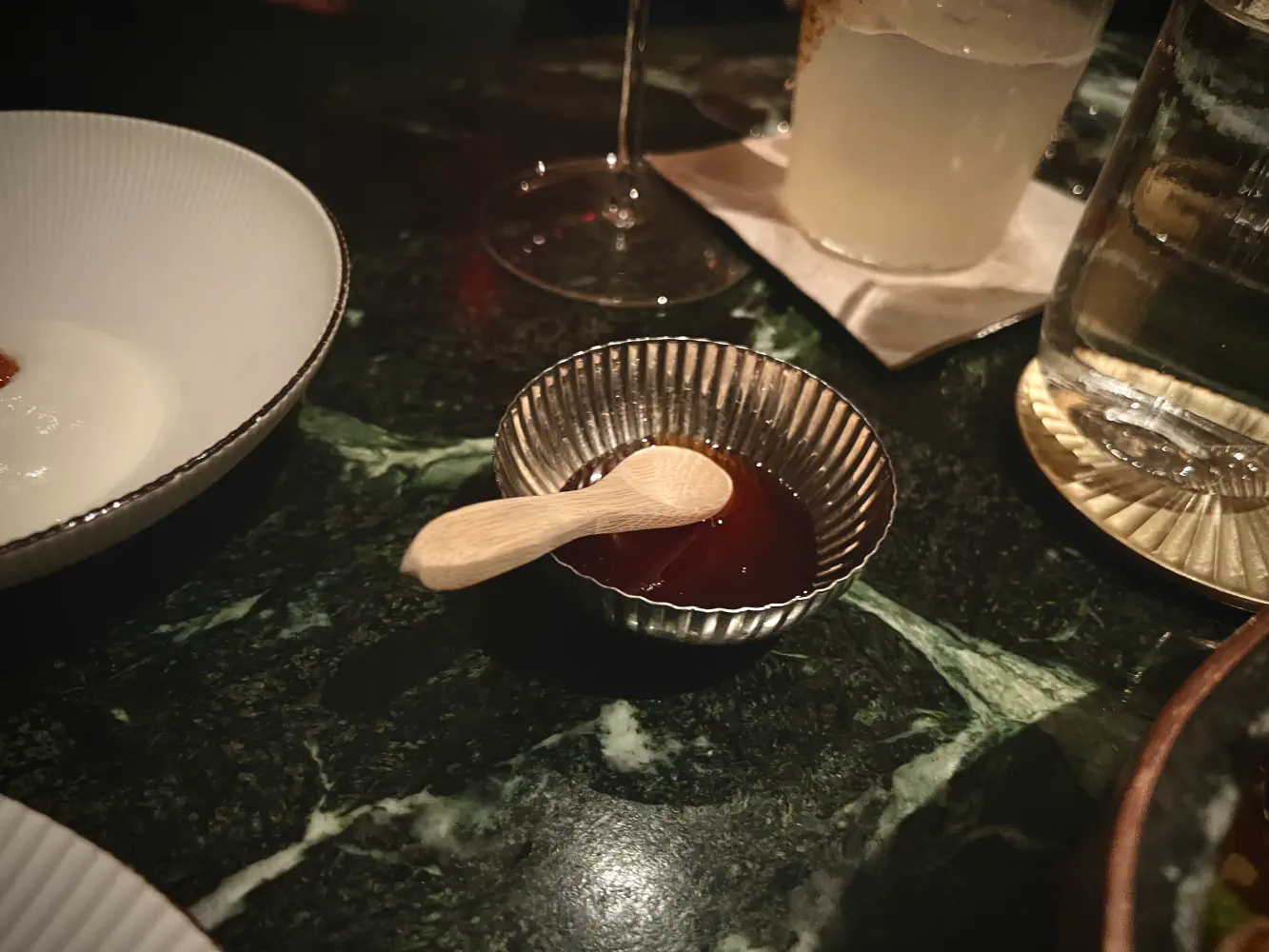
The Thai chili hot sauce was also not that spicy, and it was actually a little sweet.
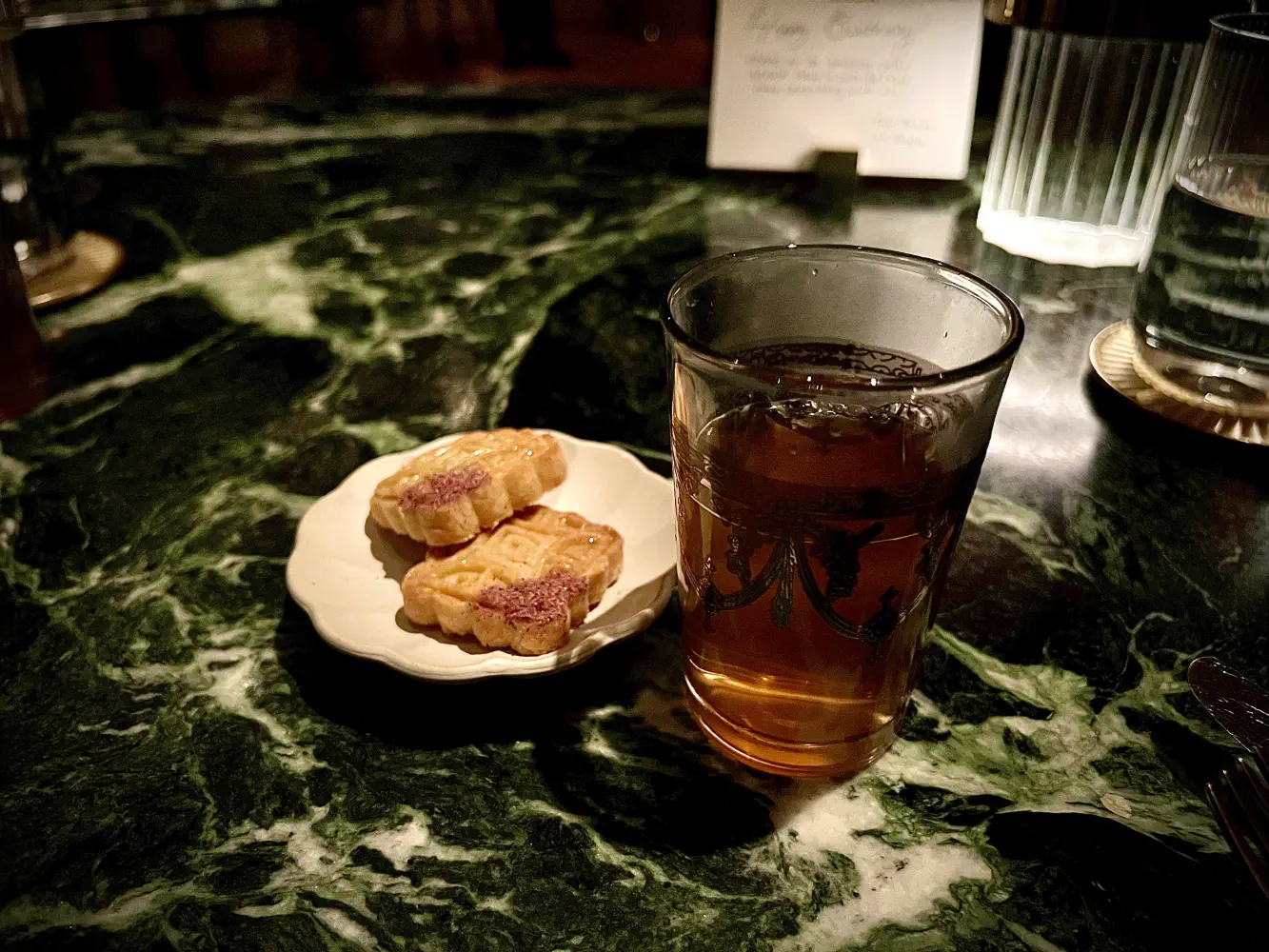
The Moroccan Tea was mint, orange blossom, date, and pistachio. They demonstrate pouring the tea into a cup a few times. The tea itself was hot, sweet, aromatic, and also very good and refreshing. The little cookies on the side was a traditional shortbread accompaniment.

The sixth and final non-alcoholic pairing was the Salted Honey Soda. This was an in-house created soda that was salted and sweet to pair with desserts.
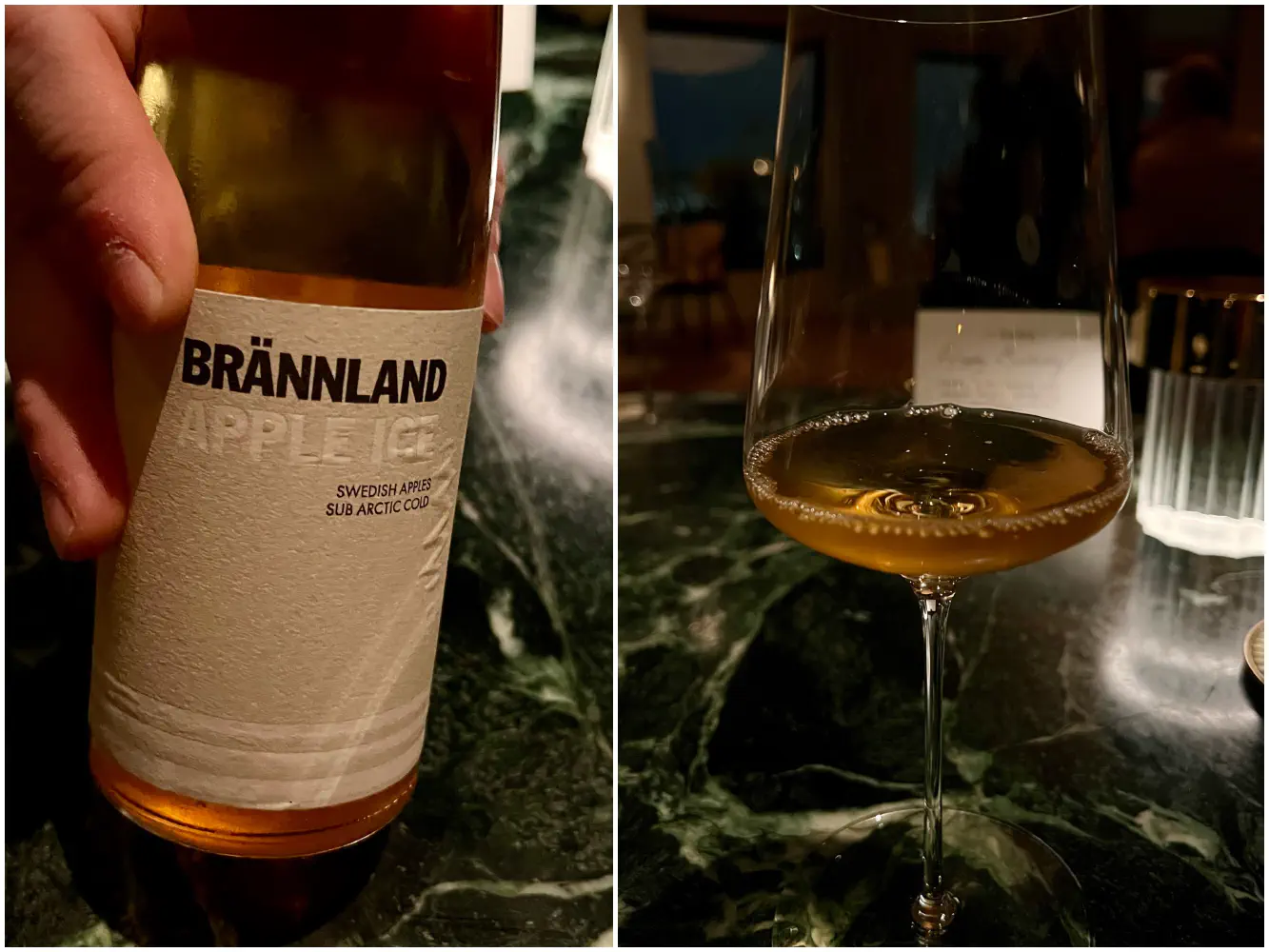
The sixth and final alcoholic pairing was the 2022 Brännland ‘Apple Ice’ Cider from Baltic Seaboard, SWE. This was an Iceland sweet wine that basically tasted like very sweet apples.
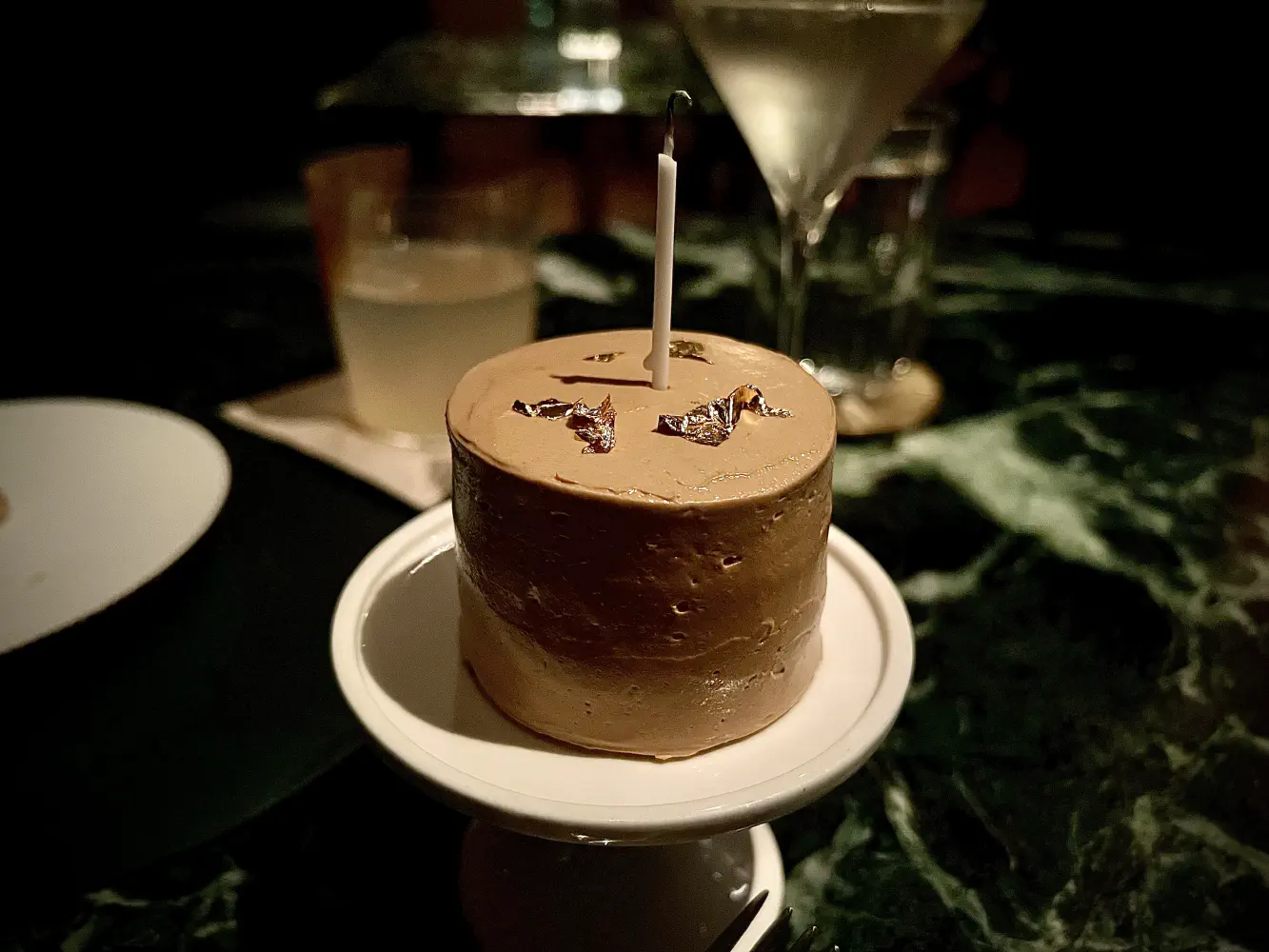
The Chocolate French cake with Mocha frosting was straightforward and decent for my partner’s birthday cake.
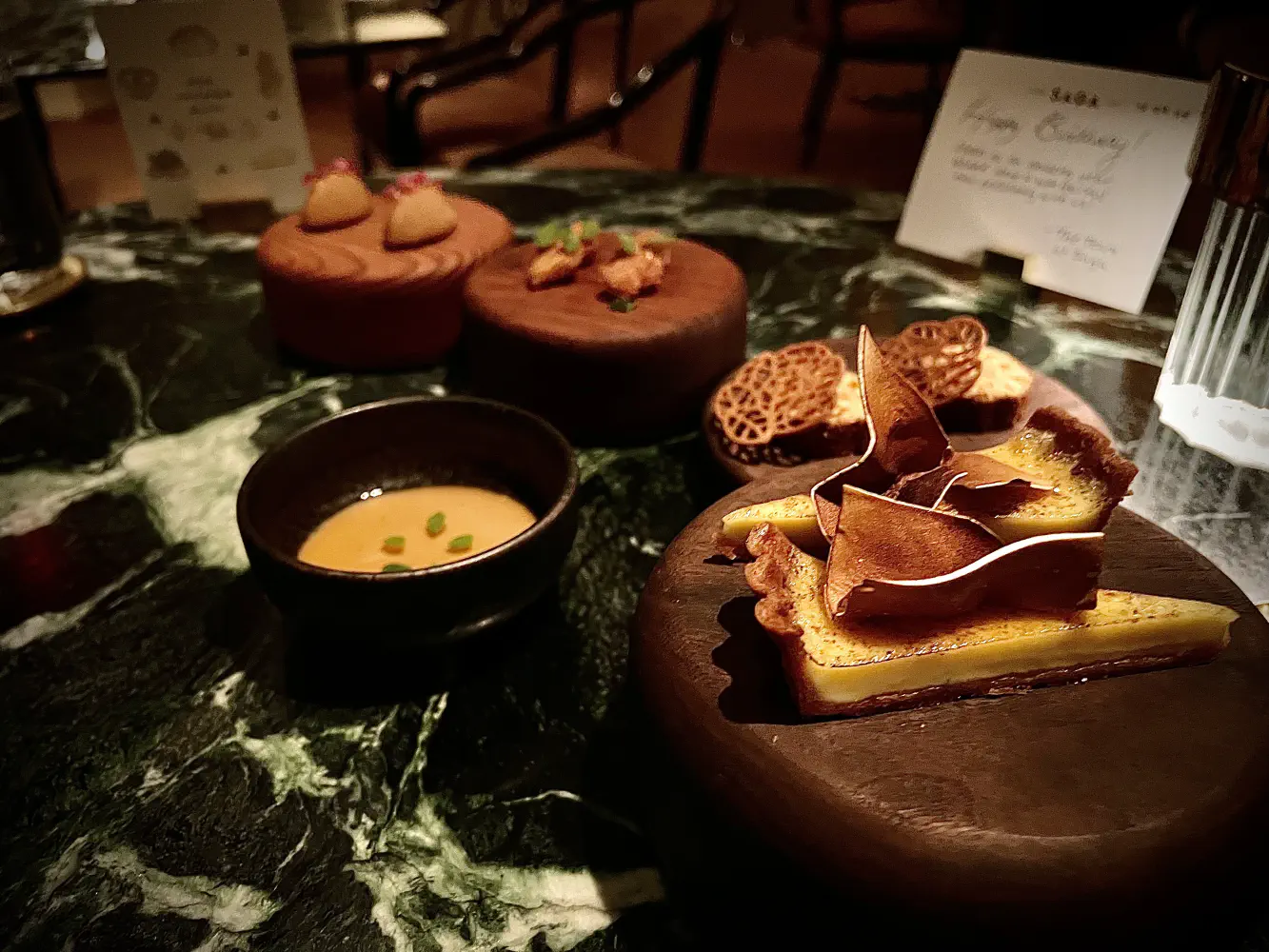
The secondary dessert tasting menu came with Birch, Sweet Potato, and Quince.
Starting far left and going clockwise:
- Brown Butter and Birch Ice Cream wrapped in a walnut pistachio brittle.
- Quince Cruller dusted with quince sugar.
- Sweet Potato Swiss Roll with cream cheese icing along a quince tuile.
- Sweet Potato Tart with toasted meringue over the top. This was pretty good.
- Birch Custard with quince leaves over the top. This was my least favorite of all the desserts here. There was just something off about the birch custard flavor that I wasn’t extremely fond of.
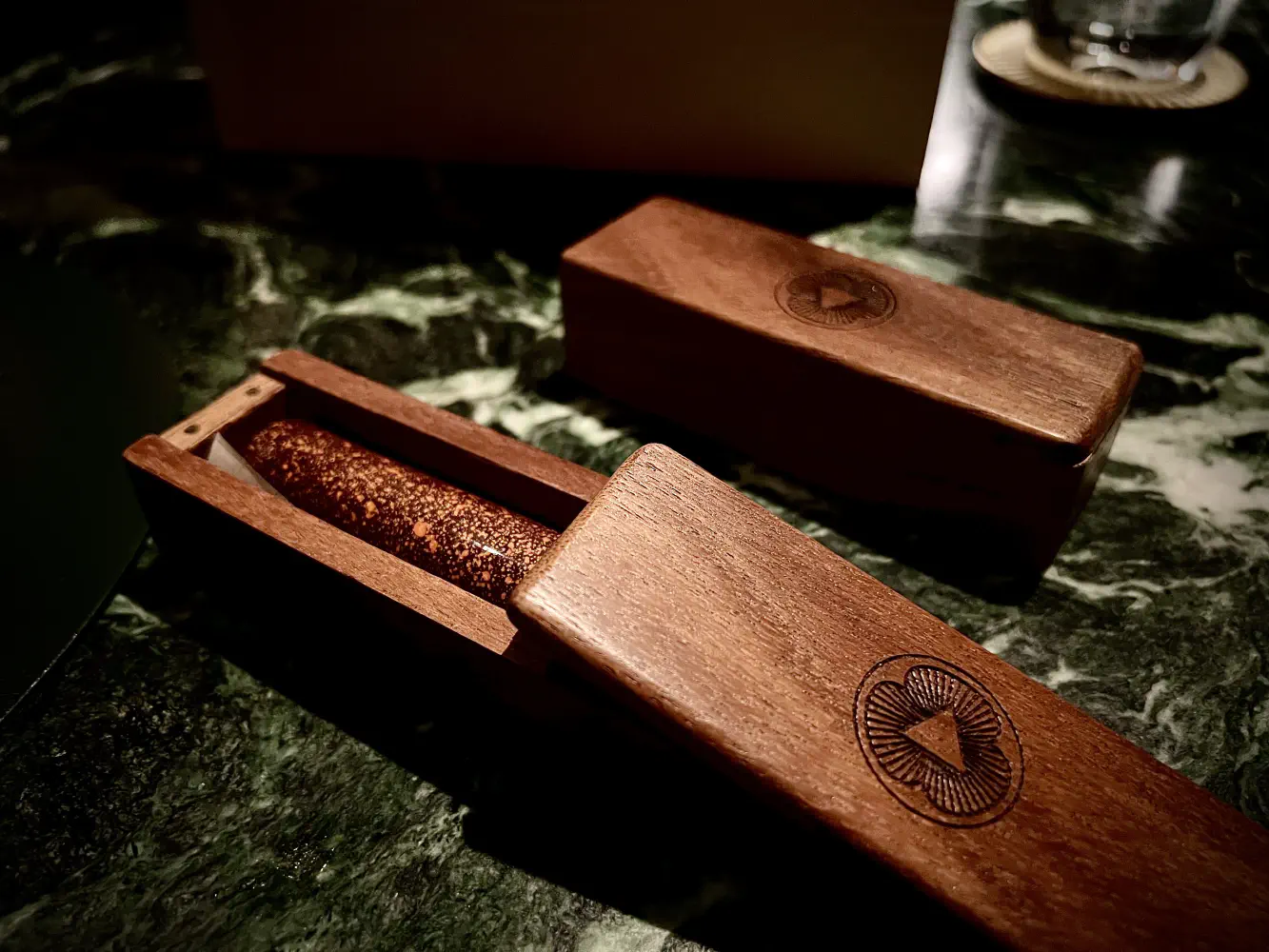
For take-home, they gave us chocolate bars with orange and coffee.
Overall Impression
SAGA was an interesting Michelin restaurant because they really pride themselves in being a blend of New York City. The food was all pretty good, and the combinations were definitely more eclectic since it was truly a blend of different flavors across cultures. If you’re tired of trying to get into super hot Michelin restaurants, this one was fairly easy to reserve for. Like its smaller sibling Crown Shy, it was overall pretty darn good.
The flavor profiles of each dish are inspired by the immigrant communities in New York City, many of which are represented in our kitchen. The unifying factor is that each dish is prepared precisely and delicately, using techniques unique to restaurants with the resources of fine dining, incorporating the flavors of North Africa, Europe, and the Middle East.
Due to the late chef’s passing and as of January 2025, there will be a new menu set forth by Charlie Mitchell, so it will be interesting to see how the menu changes from the original excerpt.
Yelp Jabs
I felt by the end the dishes were too heavy to enjoy. I opted for the wagyu vs duck and I could only eat one small piece of wagyu, I was so full I felt terrible about wasting it.
This Elitist opted for the discovery and reserve wine pairing, and I’m sure they were going all into the wines. I was full by the end, but that was due to the wine. The food is a little hefty, but it’s doable. I did not finish each wine for each course, and instead left some amounts to sample towards the end to see how the taste evolved.
Variations of seafood was a mix of three pieces - uninspired mix of fish that I could’ve gotten better with any Japanese restaurant… Duck was roasted but not crisp on the skin - not great, and some felt the duck was less tasty and definitely less cooked than they liked. Probably the worst dish of the night. You’d expect a French-influenced spot to better do the duck… As always, the company I was dining in was great, but the restaurant didn’t quite live up to the hype for me.
First off, this Elitist from New Jersey came with 17 people. It’s very difficult to rate a restaurant for a large party size, since they have to coordinate and set up special menus for everyone. Second, the duck for us was good. No one said that the duck was supposed to have a crispy skin. Cantonese Chinese roasted duck doesn’t have crispy skin. Third, this restaurant’s intention is to be a blend of cultures. So yes, you could’ve gone to a normal Japanese restaurant and got what you were looking for. The seafood varieties were using different flavors that were not Japanese specific, so this Elitist already had a misconception and false assumptions of what they were trying to do.
Revisions
- Dec 29, 2024 - Initial revision.